

Best Mexico Ruins: Ultimate Guide to 20+ Ruins in Mexico

Nestled in the jungles of Mesoamerica, the rediscovered ruins of Maya, Aztec and Zapotec cities stand as monuments to the power and knowledge of these ancient civilizations. How many of the best Mexico ruins have you visited, and which are on your bucket list?
If you’re like me, ruins check off an important part of your travel diet. Only one destination has sated my appetite for crumbling ancient ruins: Angkor Wat. After three days there, the more than 1,000 ruins of the Angkor complex led me to declare I was “templed out.” I didn’t see them all by any stretch of the imagination, but it felt like I had!
In contrast, the best Mexico ruins dot the landscape throughout the country. This makes it easier to add them on to other itineraries including Mexico’s stunning beaches, colorful colonial cities, and natural landscapes. Some of these ruins are difficult to get to, but I’ve got tips to help with that.
In this guide, I’ll share information on the top archaeological sites in Mexico: their history, highlights, and reasons for visiting, as well as information for getting there including the best Mexico ruins tours. So whether you’re looking for day trips from Cancun or Mexico City, or planning a ruins road trip, this guide will help you explore all the best ruins in Mexico.
Throughout the guide, I’ll also share virtual tours and multimedia experiences for exploring the best ruins in Mexico from home! Be sure to check out all of my Mexico travel tips and my guide to the best Mayan ruins near Cancun .
In this Guide to Ancient Ruins in Mexico:
Quintana Roo Ruins | Yucatan Ruins | Campeche Ruins | Chiapas Ruins | Oaxaca Ruins | Mexico City & Central Mexico Ruins | Other Central America Ruins

This article contains affiliate links. If you click through and make a purchase, I might earn a commission, at no additional cost to you. Thanks for your support in this way! Learn more in my Disclosure Policy .
Mexico Archaeological Sites Map
To go along with this guide, I’ve made a map of Central America archaeological sites, including the best ruins in Mexico color-coded by state. Click on each icon to open a photo and location of the site. Or click on the top left arrow for the full list.
Mexico Ruins Vocabulary
“Wow” other ruin explorers when you roll up already knowing these archaeology terms:
Ball Courts: these focal points of Mesoamerican cities are rectangular playfields with sloping walls on the two longest sides. Found in cultures throughout the region, ballgames were played for religious, social and political reasons.
Stelae : (singular – stele) tall wood or stone slabs with carved or sculpted surfaces. At Maya sites, these are usually made from stone and commemorate events or explain the function of the building they mark.
Cenotes: water-filled sinkholes formed when limestone bedrock collapses. Some are open pools, and others are caverns. Nowadays they’re great swimming holes; but the Maya made offerings to the gods at cenotes, believing that they were portals to the underworld.
Sacbeob : (singular – sacbe) roughly translated to “white way,” sacbeob are raised, limestone stucco-paved roads built by the Maya that connect temples and structures within ceremonial centers. A few connect to other communities in the region.
ⓘ Ancient Mesoamerican Ballgame Learn more about the ancient ballgame with a Google Arts & Culture feature on the ballcourts of Chichen Itza .
Best Mexico Ruins in Quintana Roo State
The Maya ruins in Mexico’s state of Quintana Roo are a must-see if you’re visiting the region. Well-run tours with English-speaking guides are plentiful, which makes seeing the ruins here easy. In particular, check out Coba where you can climb the main temple, and Tulum for its spectacular seaside setting.

Tulum Ruins | Iconic Maya Seaside Ruins
The Maya ruins at Tulum are iconic: perched at the edge of a high cliff, with sweeping views of the turquoise Caribbean waters and white sands below. Tulum was one of the last cities built and lived in by the Maya, dating to 1200 – 1450 CE, although the area was inhabited earlier. It served as a center of trade, where both sea and land trade routes converged.
Tulum was walled on three sides, with the fourth protected by the sea cliff; in fact, Tulum means “wall.” The original name of the city might have been “Zamas” meaning dawn, since it faces east and sunrises here are certainly stunning! Surviving ceremonial buildings at Tulum include the main temple overlooking the sea, called El Castillo, and several others including one with frescoes inside.
Tulum is a must-see Mexico ruins site, because of its dramatic location and sweeping views. You can also swim on the private beach, accessible by a long staircase from the cliff, and relax with the enormous resident iguanas.
Visit Tulum on a day trip from Cancun. Or to avoid the crowds, stay in Tulum or Akumal and go early in the day or later in the afternoon to avoid tourist buses. Be sure to bring a bathing suit, towel, sunscreen and hat (there’s little shade, and the white sacbeob paths reflect a ton of light!). Bring cash to pay.
Getting to the Tulum Ruins
Check out my Tulum guides for all the info you need on planning a trip: I’ve got handy tips for visiting on a budget or advice on the best beachfront hotels . Or if you’ll day trip from Cancun, here’s a good option that includes the Tulum ruins and Dos Ojos cenote or one for Tulum, Coba and a cenote .
Website | Hours 8AM – 5PM | Cost: 80 pesos; extra for parking and the train to the entrance
Facilities: Restrooms | Find a hotel in Tulum or Cancun or get my expert tips on Tulum hotels or Tulum Airbnbs
Can you climb the ruins: No | Can you hire a guide onsite: Yes

Coba Maya Ruins
Coba is one of the first ancient Mexico ruins I visited, and it’s still a favorite. Exploring its jungle setting and sprawling complex gives you serious Indiana Jones vibes. Coba sat at the nexus of the largest network of sacbeob in the Maya world, which connected structures within Coba as well as neighboring cities. The name Coba in Mayan means “waters stirred by the wind,” perhaps due to its place on two large lagoons.
Coba was estimated to have more than 50,000 residents at its peak. It flourished between 600-900 CE, and was abandoned around the time of the Spanish colonization. Like all Maya sites, the reason is unknown; although leading theories are drought, disease, overpopulation and destruction of the environment due to overfarming. It’s likely that a combination of factors led to the Maya downfall.
Coba is notable for several reasons. First, it has a large number of surviving stelae with images and Maya hieroglyphic writing, which give insight into important aspects of Mayan rituals, politics, and history. Women are depicted in positions of power in some of the stelae scenes. Also, the largest temple of Coba, Nohoch Mul, can be climbed: it’s 137 feet high (42m), with expansive views over the jungle.
How to Get To the Coba Mayan Ruins
Coba is only about 45 minutes from Tulum, and can be combined with cenotes in the area like Choo-Ha. The site is large, so it’s easiest to get around by bike which can be rented there. Be sure to bring sunscreen, water, suitable shoes ( I love these! ), bug spray and a hat, as well as a bathing suit and towel if you plan to visit cenotes. Bring cash to pay.
Tours: here’s a good tour from Cancun to Coba and Tulum , a tour that includes snorkeling , or a Coba sunset tour .
Website | Hours 8AM – 5PM | Cost: 80 pesos; extra for parking and bicycle rental
Facilities: Restrooms, restaurants, limited hotels | Find a hotel
ⓘ Mayas vs. Mayan: which is correct? For English speakers, this is especially confusing. The word Maya can be both a noun or an adjective, and singular or plural! (Examples: “She is Maya,” “They are Maya,” “Maya ruins,” “Maya culture.”) Today’s native speakers of Maya in the Yucatán Peninsula also refer to their language as Maya. In contrast, scholars refer to the family of languages spoken by Maya people as Mayan. (You might note that I have used “Mayan” incorrectly in this article a few times since Google prefers that term!)
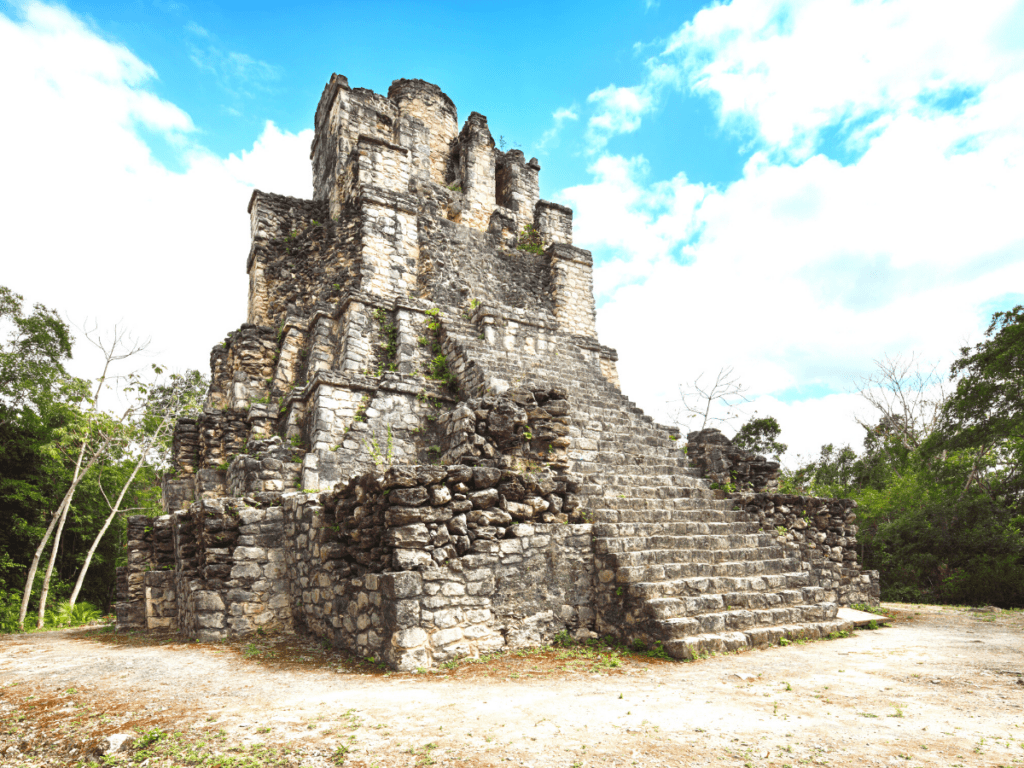
Muyil (Chunyaxche) | Maya Ruins in Sian Ka’an
The Muyil ruins are located about 15 miles south of Tulum in the Sian Ka’an Biosphere. Set deep in the lush jungle, Muyil is less impressive than Tulum, but also less crowded and touristy. Ruin-lovers in the area could check it out on a day trip to the biosphere. The architecture here is known as “Peten” style, meaning similar construction and design as the ruins at Tikal in Guatemala.
Muyil was one of the earliest Maya cities on the coast, settled as early as 300 BCE. It is situated on the Sian Ka’an lagoon, a name meaning “where the sky is born.” (If you visit and see the beauty of the biosphere, you’ll understand how it got this name!) There is a boardwalk through the jungle that takes you to a lookout over the lagoon.
How to Get to Muyil
You can take a colectivo (shared van) from Tulum, arrange a taxi for the day, or take a tour that combines the ruins with other activities. Be sure to bring sunscreen, water, suitable shoes ( I love these! ), bug spray and a hat, as well as a bathing suit and towel if you plan to swim. Bring cash to pay.
Tours: Check out this tour of Sian Ka’an and Muyil from Tulum or see Muyil and an ancient Maya trade route before relaxing on a canal float.
Website | Hours 8AM – 5PM | Cost: 45 pesos; extra 50 pesos for the boardwalk
Facilities: Restrooms | Find a Tulum hotel or grab my hotel tips or my guide to the best Tulum Airbnbs
Can you climb the ruins: Yes | Can you hire a guide onsite: No
More Quintana Roo-ins (Get it?)
If you’re in Quintana Roo and not templed-out yet, check out a few more Maya archaeological sites:
Xelha (pronounced “shel-ha”): located across the highway from the popular Xel-Ha waterpark between Tulum and Akumal, this small site has visible murals and a cenote you can visit.
Chacchoben , Kohunlich , and Dzibanche and Kinichna : these ruins are located near Chetumal, Mahahual, and Bacalar. Kohunlich is notable for its Temple of the Masks stairway, which is flanked by huge humanized stucco masks. All are popular day trips from the cruise port in Chetumal. For a ruins tour option from Bacalar, check out this itinerary for Maya sites and nature photography .
ⓘ What are colectivos? Grab a guide to taking shared van colectivos between Cancun and Tulum here .
Best Ruins in Yucatan State
Mexico’s ruins in Yucatan state are some of the most famous, and several have UNESCO status. Legendary Chichen Itza is here with its iconic pyramid and ball court. Other Maya sites include Ek Balam, noted for its well-preserved sculptures, and Uxmal, with its intricate carved facades. They are easy to visit on day trips, with many good guided tour options.
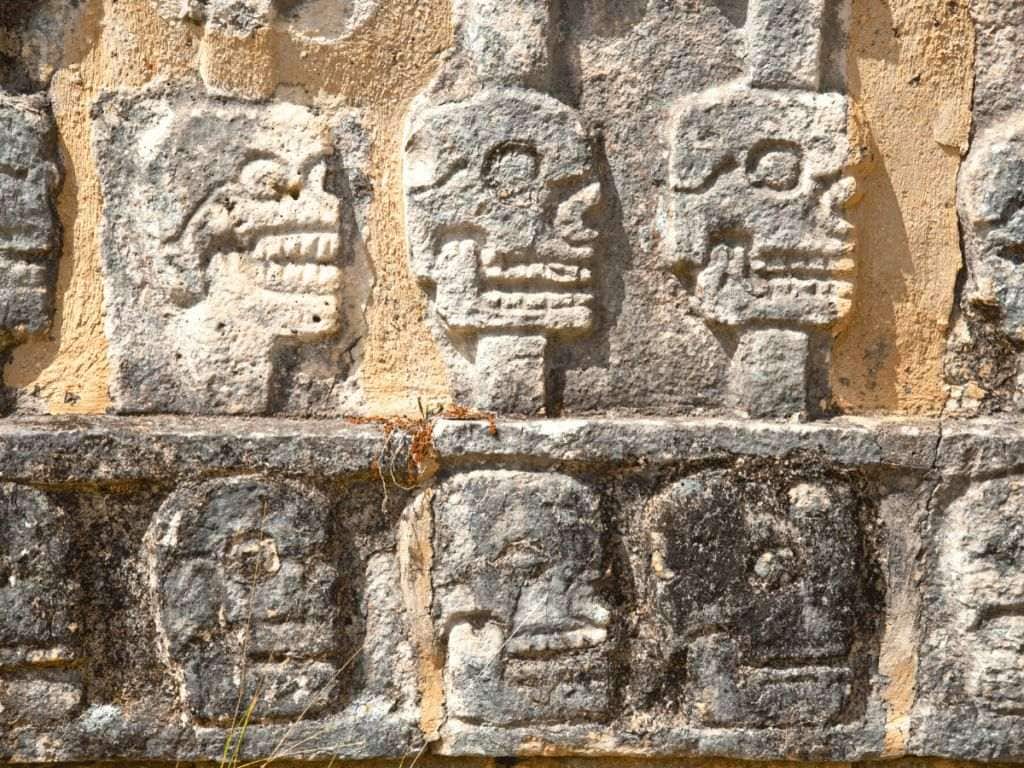
Chichen Itza | UNESCO Site & World Wonder
Chichen Itza is the celebrity entry on this list: it’s a UNESCO World Heritage Site and was voted one of the New 7 Wonders of the World. It’s also one of the most-visited tourist sites in Mexico; try not to visit during school holidays and the equinoxes!
Chichen Itza was at its peak from 750 to 1200 CE as a center of trade and culture. It fell into rapid decline around 1200, and was abandoned around 1500 at the time of Spanish colonization. Chichen Itza’s blend of architecture, with stylistic influences from central Mexico and other Maya regions, make it an important Mesoamerican ruin site and a must-see for ruin enthusiasts.
Surviving monuments at Chichen Itza include the main temple, the Pyramid of Kukulkan (also known as El Castillo); the Great Ball Court, the largest of its kind in Mesoamerica; El Caracol, an astronomical observatory; and the Temple of Warriors, an enormous temple with hundreds of stone columns. You can also see the Sacred Cenote, where the Maya made offerings of jade, gold, and even sacrifices.

How to Get to Chichen Itza Ruins
Chichen Itza can be seen on a full day trip from other cities in the region like Cancun, Merida, or Tulum. Tour itineraries often include a visit to nearby cenote Ik-Kil, which gives a welcome chance to cool off after a visit to the ruins. Be sure to bring sunscreen, water, suitable shoes ( I love these! ), and a hat, as well as a bathing suit and towel if you plan to visit the cenote.
Chichen Itza Tours from the Riviera Maya and Merida
Check out this all-inclusive tour of Chichen Itza, Valladolid and Cenote Ik-Kil , or this itinerary that includes Coba , or even a sunrise Chichen Itza tour to beat the crowds . If you want to add on the Xel-Ha park, there’s an all-inclusive option that also goes to Xcaret cenote. If you’re based in Merida, here’s a good Chichen Itza itinerary.
Website | Hours 8AM – 4PM | Cost: 480 pesos; extra for parking
Facilities: Restrooms, restaurants, lockers, hotels | Find a hotel or get my expert Tulum hotel tips
ⓘ Chichen Itza Virtual Tour Explore Chichen Itza virtually from home with a feature from Google and the British Museum and also a 360-degree virtual Chichen Itza tour from National Geographic .

Ek Balam | Maya Ruins near Valladolid
The lesser-known Maya site of Ek Balam is about 15 miles north of the city of Valladolid , and means “black jaguar” in Mayan. It’s notable for its well-preserved sculptures and stonework, panoramic views, and a four-sided entry arch.
First settled in 100 BCE, most of the buildings at Ek Balam were constructed around 600-900 CE. Must-see sights here include the Acropolis, restored stucco facades, and views of the jungle. There is also a cenote, X’Canche, where you can cool off after your visit.
Get there: Ek Balam can be seen on day trip from other cities in the region like Valladolid , Cancun, Merida, or Tulum. You can take a taxi or colectivo from Valladolid, or book a tour with transportation. Be sure to bring sunscreen, water, suitable shoes ( I love these! ), bug spray, and a hat, as well as a bathing suit and towel if you plan to visit the cenote. Bring cash to pay.
Tour options: These are itineraries that include Chichen Itza or Ek Balam and cenotes . Another popular day trip in this area is Rio Lagartos – check out my guide here .
Photo caption: on a clear day, you can see the temples of Chichen Itza and Coba on the horizon from the top of Ek Balam’s Acropolis, which is 90 feet (30m) high.
Website | Hours 8AM – 4PM | Cost: 480 pesos; extra for the cenote
Facilities: Restrooms | Find a Valladolid hotel or see the cool Airbnb where I stayed and grab all of my Valladolid visit tips
Can you climb the ruins: Yes | Can you hire a guide onsite: Yes
READ NEXT: My full guide to visiting Ek Balam and Cenote X’Canche on a day trip or guided tour!
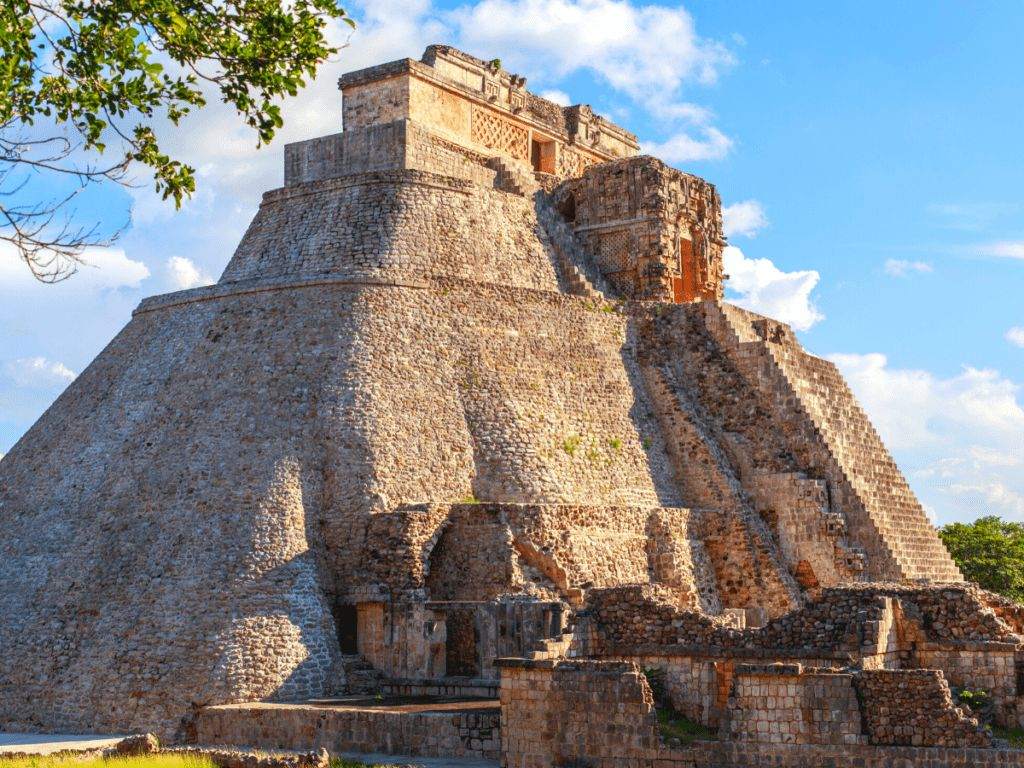
Uxmal Maya Ruins | UNESCO Heritage Site
Designated as a UNESCO World Heritage Site , Uxmal (pronounced “oosh mahl”) is one of the most important Maya archaeological sites. It is built in the “Puuc” architectural style of the region, with building facades made of plain blocks on the lower part of structures, and intricate mosaics on the upper sections. Puuc design also used a concrete core for support beneath the veneer blocks.
Founded around 500 CE, Uxmal flourished as a regional capital from 850-950, then started to decline. Since the Spaniards didn’t build a city there, it was largely abandoned after 1500.
Uxmal is about an hour south of Merida, and there are three other smaller ruins sites in the same area: Kabah , Labná and Sayil . These sites share the UNESCO designation with Uxmal. If you want to see a less crowded ruin that looks like a smaller version of Chichen Itza, Mayapan is also within an hour drive from Merida.
How to Get to Uxmal
Uxmal can be seen on a day trip from Merida or Valladolid. You can take a bus or taxi from Merida and/or stay overnight and see all the ruins in this area. Be sure to bring sunscreen, water, suitable shoes, a hat and cash to pay.
If looking for a tour, check out this tour to Uxmal and Kabah from Merida or this itinerary with the Loltun caves, Sayil, Xlapak and Labna .
Website | Hours 8AM – 5PM | Cost: 413 pesos
Facilities: Restrooms, restaurants, hotels | Find a hotel in Uxmal or Merida
Planning a trip to Merida, Yucatan ? Don’t miss all my tips for visiting this colorful colonial gem or the charming nearby city of Valladolid .

Dzibilchaltun Maya Ruins and Cenote Xlacah
Located about 10 miles north of Merida, Dzibilchaltun is a small Maya site. Dzibilchaltun is notable for its accompanying museum, beautiful cenote Xlacah, and its Temple of the Seven Dolls, named for small effigies discovered during excavation.
How to Get to Dzibilchaltun
Dzibilchaltun can be seen on a half day trip from Merida or Valladolid, or combine it with other sites in the region like Progreso. You can take a colectivo or taxi from Merida, or book a tour like this itinerary that includes Progreso . Be sure to bring sunscreen, water, suitable shoes, a hat and cash to pay.
Website | Hours 8AM – 4/5PM | Cost: 250 pesos
Facilities: Restrooms, restaurant, lockers, museum | Find a hotel in Merida
Can you climb the ruins: Yes | Can you hire a guide onsite: Yes
ⓘ Small Group Adventure Tours to See Mayan Ruins Want to visit the ruins of Central America but not sure where to start? A small group adventure tour is a fun, easy, and cost-effective way to travel in Latin America, especially for solo or new travelers. Check out this trip with G Adventures to Mexico and Guatemala , or this Mexico – Guatemala – Belize itinerary from Intrepid Travel . And if you’re not sure if group tours are for you, be sure to read this post ! (Spoiler: they are!)
Best Mexico Ruins in Campeche State
The Mexican state of Campeche has more than 1,000 registered archaeological sites. Unlike the ancient ruins of other Mexico states, though, they receive relatively few visitors due to their more remote locations. The most-visited ruins are accessible mainly from two cities: from Bacalar on the east, and from the capital city of Campeche on the west coast. The largest site, Calakmul, is set deep in a 2,800 square mile biosphere reserve. All of this lets you explore the ruins at a slower pace and experience the power of their natural settings.

Calakmul | UNESCO Site & Remote Maya Ruins
Hidden in the jungle of the Mexican state of Campeche, just 20 miles from the border with Guatemala, lies the Maya archaeological site of Calakmul. At its height, Calakmul was a major power and important Maya city. Calakmul is sometimes referred to as “The Kingdom of the Snake” due to their extensive use of a snake head sign as their emblem glyph. Its well-preserved ruins and surrounding tropical forest ecosystem are now a UNESCO site .
Calakmul is notable for one of the highest pyramids in the Maya world at 148 feet (45 meters). And you can climb it! Calakmul also has the greatest number of stelae discovered (120). Calakmul’s location in a tropical forest means you’re likely to encounter a variety of flora and fauna including spider and howler monkeys, colorful wild turkeys, agoutis, coati, toucans, and green parrots. Nearby there is also the smaller site of Balamku , known for a stunning preserved stucco frieze.
How to Get to Calakmul
Calakmul is remote, located well into the biosphere off the road. To see the site, it’s easiest to stay overnight in the town of Xpuhil or near the entrance to Calakmul in Conhuas. Be sure to bring sunscreen, water, suitable shoes, a hat and cash to pay. Or check out this tour option that departs from Bacalar or Palenque .
Website | Hours 8AM – 5PM; enter by 3PM | Cost: Community, national park, and ruin fees (paid separately) total around 180 pesos
Facilities: Restrooms | Find a hotel in Conhuas or Xpuhil

Becan Maya Ruins
Occupied since around 550 BCE, Becán grew in political, religious and economic importance until reaching its peak in 600-900 CE. Fragments of trade goods indicate that it might even have traded with Teotihuacan outside Mexico City. Becan is notable for being surrounded by a moat, the only one found in a Maya settlement. For this reason, the archaeologists who rediscovered it gave it the modern Mayan name Becán, meaning “ravine or canyon formed by water.”
Its architectural style known as “Rio Bec” is characterized by a central tower flanked by two false, very steep towers. This area is known as the Rio Bec region, named after other ruins discovered deep in the Calakmul reserve. The Rio Bec ruins themselves are quite remote; you would have to find a guide to take you via ATV due to very poor roads to the site.
Ruin lovers can check out the more accessible nearby sites of Xpuhil , Chicanna and Hormiguero in the same day. They are all within about 15 miles (24km).
How to Get to Becan
To visit Becan, it’s easiest to stay overnight in the town of Xpuhil or near the entrance to Calakmul in Conhuas. Be sure to bring sunscreen, water, suitable shoes, a hat and cash to pay.
Website | Hours 8AM – 5PM | Cost: 60 pesos

Edzna | Maya Ruins near Campeche
Edzná is an impressive Maya site, with a mixture of architectural styles spanning years from 300 BCE to 1200 CE. The main temple is built on a wide platform and has five stories, totaling 165 feet high (50m). A cluster of structures known as the “Old Sorceress Group” includes a Temple of the Witch. Other notable ruins include a 32 stelae, a ball court, an astronomical observatory, and a temple with well-preserved masks of the sun god.
Edzna was an influential political and economic regional capital. The name Edzná comes from “House of the Itzas,” which suggests that the city was influenced by the family of the Itza name before they founded Chichen Itzá. The architectural style of this site shows signs of the Puuc style, even though it is far from those sites.
How to Get to Edzna
Then ancient ruins of Edzna can be visited on a day trip from the pretty colonial capital city of Campeche (also called Campeche), which is about an hour away, or here’s a tour option from Merida that includes Campeche . Be sure to bring sunscreen, water, suitable shoes, a hat and cash to pay.
Facilities: Restrooms | Find a hotel in Campeche or check out the spectacular Hacienda Uayamon
Best Chiapas Ruins
Deep in the mountainous Chiapas state, there are two must-see Maya sites that are top things to do in San Cristobal de las Casas . Here you will find Palenque, one of the most mythical Maya sites and best ruins in Mexico. Other ruins in this region are more remote, including one that is accessible only by boat! Travel in Chiapas is not without risk; I visited here on a small group tour, and recommend checking travel advisories if you go without a guide. Travel on roads after dark is not recommended.

Palenque | Iconic Maya Ruins near San Cristobal
A dramatic forest setting and heavily-adorned buildings make Palenque one of my favorite ancient Maya sites. I arrived here early in the morning just as fog was lifting, which cemented its magical status in my mind. This site contains some of the finest Maya architecture, sculpture, carvings and roof combs (decoration on the tops of temples) that the Maya produced. Much of the history of Palenque has been reconstructed from reading the preserved carvings and hieroglyphic inscriptions on its monuments.
Palenque reached its peak between the years 500 and 700 CE but declined sharply thereafter, and was lost to the jungle for hundreds of years. It is a large site, encompassing around 50 square miles, only about 10% of which has been excavated. The many structures here include temples, terraces, plazas, burial grounds, and a ball court. You can climb some of the ruins for impressive views of the most famous temple called The Temple of the Inscriptions. Also don’t miss the hiking trails through the jungle with waterfalls and wildlife including monkeys.
How to Get to Palenque
Palenque can be visited on a day trip from San Cristobal de las Casas, or stay at a hotel near the site in Palenque. To see some of the ruins, it might be required to have a guide. Be sure to bring sunscreen, water, suitable shoes, bug repellent, a hat and cash to pay. Be aware of security conditions in the area and do not travel on roads after dark.
Tours: From San Cristobal, here’s an itinerary for Palenque with the Agua Azul waterfalls .
Website | Hours 8AM – 5PM | Cost: 80 pesos
Facilities: Restrooms, museum, cafe, gift shop | Find a hotel in San Cristobal , Palenque or check out the secluded Hotel Boutique Quinta Chanabna a few miles from the site
ⓘ Virtual Tour of Palenque Take a virtual visit to Palenque with Google Arts & Culture , with both modern photos and pictures taken in 1891 by British explorer Alfred Maudslay.

Bonampak | Maya Ruins with Vivid Frescoes
The explorer and Mesoamerican anthropologist Jacques Soustelle called Bonampak “a pictorial encyclopedia of a Maya city,” due to its extraordinary murals. These painted frescoes depict scenes of Maya life including rituals and warfare and are in astonishingly good condition. They are meant to be read together, to tell a story. Depending on the number of other visitors, though, your time to view the murals may be very limited. Be sure to take photos (without flash, of course) so you can pore over them later!
Hidden deep in the Lacandon jungle, Bonampak is a small site. Other than the frescoes, its main features are a Grand Plaza with its surrounding structures and the Acropolis. The site is built among a series of low terraced hills, with the Acropolis built into the hillside itself.
How to Get to Bonampak
I have not visited Bonampak yet, but other travelers report that you cannot drive into the archaeological park itself. It seems that there is a “shuttle service” (and I use this term very loosely) provided by locals for the last step, for around 150 pesos a person round trip.
The road conditions are very poor, so it’s probably best to avoid wear and tear on a rented vehicle anyway. (Also it doesn’t seem that you can refuse and still get to the site!) Chiapas state has the highest poverty rate in Mexico; if you want to see this site, just budget for this “last mile” transportation that contributes to the local economy.
Be sure to bring sunscreen, water, suitable shoes, bug repellent, a hat and cash to pay. Be aware of security conditions in the area and do not travel on roads after dark.
Alternatively, you can book a tour from Palenque like this one to see both Bonampak and Yaxcihilan.
Website | Hours 8AM – 5PM | Cost: 70 pesos plus see note on “shuttle service” above
Facilities: Restrooms, museum | Find a hotel in San Cristobal , Palenque or Lacanja near the site
Can you climb the ruins: Yes | Can you hire a guide onsite: No

Yaxchilan | Ruins with a Riverside Setting
Perched on the western bank of the Usumacinta River, Yaxchilán (“the place of green stones”) lay along the trade route between the two great Maya cities of Palenque and Tikal. To get here, you’ll need to take a boat along the river that forms part of the border between Mexico and Guatemala.
Notable for its temples and beautiful carvings, Yaxchilan has acropolises with temples, grand staircases, and a palace. Local legends say that a headless sculpture of a god here would bring about the end of the world if his head is replaced. (So don’t move any stone heads when you go!)
How to Get to Yaxchilan
Yaxchilan is accessible by boat from the pier in Frontera Corozal, or take a tour from Palenque to both Yaxchilan and Bonampak . Be sure to bring sunscreen, water, suitable shoes, bug repellent, a hat and cash to pay. Be aware of security conditions in the area and do not travel on roads after dark.
Website | Hours 8AM – 5PM | Cost: 60 pesos plus boat fee
Facilities: Restrooms | Find a hotel in Palenque , Lacanja or Frontera Corozal
Best Ruins in Oaxaca State
The state of Oaxaca, located in Southwestern Mexico, was home to the Zapotec and Mixtec people among others, and contains ancient ruins from these pre-Columbian civilizations. The two most well-known sites are easy to visit on day trips from the state capital Oaxaca de Juarez (Oaxaca City), a destination rich in indigenous culture and history. Monte Alban and Oaxaca are a UNESCO site.
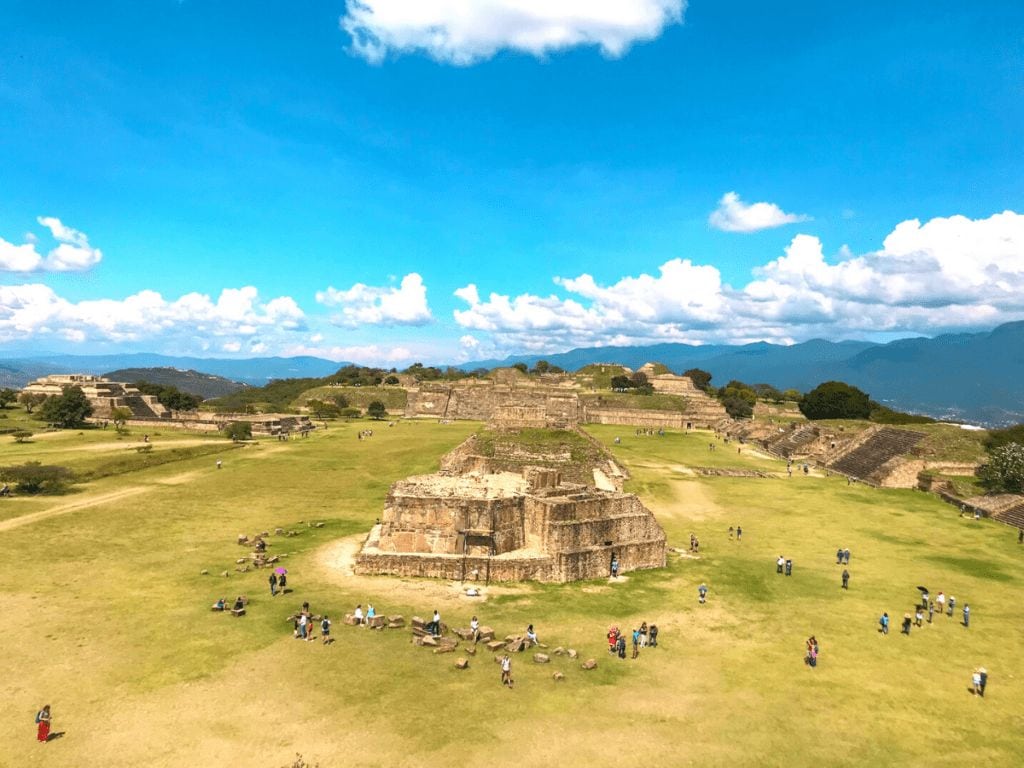
Monte Alban | Zapotec Ruins in Mexico
One of the earliest cities of Mesoamerica, Monte Alban in Oaxaca flourished for over a thousand years from 500 BCE to 850 CE. It was the socio-political and economic center of the Zapotec people. Monte Alban is an elaborate site, with plazas, pyramids, a ball court, canals, and tombs. As the Zapotec culture declined in the fourteenth century, areas of Monte Alban were then occupied by Mixtec peoples.
Designated a UNESCO site in conjunction with the city of Oaxaca, Monte Alban is notable for its architecture which bears similarities to the Teotihuacan ruins near Mexico City. Although never as large as Teotihuacan, there is evidence of trade between the two cities. Its hieroglyphs also contain some of the earliest writing in Mesoamerica.
If you visit Oaxaca, you must visit Monte Alban to appreciate the history and culture of the region. Climb the south platform for dramatic views of ruins and the valley against the backdrop of the Sierra Norte and Sierra Sur mountains. Be sure to check out my guides to visiting Oaxaca for Dia de los Muertos and all of the top Oaxaca sights .
How to Get to Monte Alban
Monte Alban can be seen on a day trip from Oaxaca. Take a shuttle from the city, or book a tour with a guide to fully appreciate the site (and avoid the shuttle delays as it stops colectivo-style for passengers along the route). Be sure to bring sunscreen, water, suitable shoes, a hat and cash to pay. Here’s a good Monte Alban half-day tour from Oaxaca or this full-day Monte Alban itinerary that also includes Arrazola, Coyotepec and Cuilapam.
Facilities: Restrooms, museum, restaurant, gift shop | Get my guide to hotels in Oaxaca

Mitla | Zapotec Ruins in Oaxaca
As the former cultural and religious center of the Zapotec people, Mitla is another important archaeological site in Oaxaca. Mitla began to gain prominence as the capital Monte Alban declined, reaching its peak in 700-900 CE. Between 900 and 1500 the Mixtecs moved down from northern Oaxaca and took possession of Mitla; the Mixtec influence is most pronounced on the remaining ruins. It is well preserved due to the cold, dry climate of the Oaxaca Valley.
The most important architectural feature of Mitla halls are carvings, either carved into the stone or built up of individual stone pieces like a mortarless mosaic, which cover their exterior walls. The site is most famous today for its huge rectangular building, the Hall of the Columns, which is richly decorated in these geometric relief carvings. When the Spanish arrived in the 16th century, they built the Church of San Pablo above one of the original platforms to keep the gods of the underworld trapped in the ground.
How to Get To Mitla
Mitla can be seen on a day trip from Oaxaca by bus. Or you can take a tour; Mitla itineraries usually include other sites in the region.
Tours: There are many options! You can see both Monte Alban and Mitla in one day, or take a tour combining Mitla with Hierve el Agua waterfall , Santa Maria de Tule, and Teotitlan de Valle. This itinerary adds on a mezcal tasting at the end of the day.
Website | Hours 8AM – 5PM | Cost: 75 pesos
Facilities: Restrooms | Get my guide to the best hotels in Oaxaca
Can you climb the ruins: You can climb down into some of the tombs
Can you hire a guide onsite: Yes
Mexico City Ruins & Central Mexico Ruins
Unlike the Maya ruins found throughout the Yucatan Peninsula, the ruins surrounding Mexico’s capital city were built by different civilizations – Teotihuacanos, Toltecs, Aztecs and more. Teotihuacan is here, possibly the largest and most influential city in the history of the New World. It’s easy to see the most significant ruins on day trips. When I visited, I was surprised to find ancient ruins in the center of Mexico City!

Tenochitlan – Templo Mayor | Aztec Ruins in Mexico
The ancient city of Tenochitlan was built upon a lake in what is now Mexico City by the Mexica people. This founding fulfilled one of their ancient prophecies. Also known as the Aztecs, the Mexica were great warriors and formed a regional alliance in order to conquer their most powerful rivals. By the time the Spanish arrived, the Aztecs ruled over as many as 5 to 6 million people in the region. The capital of Tenochitlan alone had over 200,000 inhabitants and was a huge center of trade.
By 1521, the Spaniards had conquered the Aztecs by alliances with their enemies, superior weapons, and the help of smallpox. They razed the city and built the capital of New Spain in its place.
Excavations on Tenochitlan’s Templo Mayor began in 1978 after utility workers unearthed ruins. Today, excavations continue providing insight into life during the height of Aztec rule. Mexico City’s Zocalo is located at the site of Tenochtitlan’s original central plaza and market. Be sure also to see the Aztec Sun Stone, which was discovered here in 1790 and is on display in the National Museum of Anthropology.

How to Get to Templo Mayor and Tenochitlan
The ancient ruins of the Templo Mayor are located in the city center. I had an amazing Mexico City historical center Airbnb experience that included a short visit to the ruins, but you could also book a private tour with the same historian and guide Pau to explore the ruins in greater depth.
Website | Hours 9AM – 5PM | Cost: 80 pesos | Find a hotel in the historic center of Mexico City

Teotihuacan | Mexico City Ruins Day Trip
Located about 25 miles north of Mexico City, Teotihuacan is Mexico’s most-visited ancient archaeological site as well as a UNESCO Heritage Site . Teotihuacan was built between 200 BCE and 600 CE, and became the largest and most populous city in Mesoamerica until its collapse around a hundred years later. At its peak, it had more than 150,000 inhabitants. The name of the civilization that built Teotihuacan is unknown; the city’s name was given by the Aztecs centuries later.
Teotihuacan is arranged in a grid layout that covers about 8 square miles (20 square kilometers). The main buildings are connected by the Avenue of the Dead, and include The Pyramid of the Moon, the Pyramid of the Sun, the Ciudadela (“Citadel”) and the Temple of Quetzalcoatl (the Feathered Serpent).
The Pyramid of the Sun is 216 feet high (66 m) and can be climbed; get there early to avoid the long line of ruin-climbers. The Pyramid of the Moon provides an impressive view of the Avenue of the Dead. A number of paintings and frescoes also survive, and there is an on-site museum that displays artifacts found during excavation as well as a model of the city.
Get there: Teotihuacan is accessible by public bus from Mexico City. Or check out this itinerary with a professional photographer as guide Or beat the crowds with a sunrise tour , a sunset tour , or hot air balloon ride over Teotihuacan .
PRO TIP: When you visit, be sure to follow the Avenue of the Dead all the way to the end. Climb up the viewing platorm there to see the Temple of Quetzalcoatl hidden behind. This is the best-preserved structure onsite.

Tula | Toltec Ruins in Mexico
Another day trip from Mexico City, the city of Tula was an important regional center as the capital of the Toltec Empire. The Toltecs and Tula flourished between the fall of Teotihuacan and the rise of Tenochtitlan. The site is most known for the Atlantes of Tula, enormous basalt sculptures of Toltec warriors, and the Pyramid of Quetzalcoatl.
How to Get to Tula
Tula, located in Tula de Allende in Hidalgocan, can be seen on a day trip from Mexico City. Most tours to Tula are private: check out this itinerary for both Tula and Teotihuacan , a tour of Tula and Teotihuacan with the Anthropology Museum , or Tula And Tepotzotlán .
Website | Hours 9AM – 5PM | Cost: 75 pesos
Facilities: Restrooms, museum | Find a hotel in the historic center of Mexico City

Puebla: The Great Pyramid of Cholula
In Puebla, Mexico you’ll find the Great Pyramid of Cholula, also known as Pirámide Tepanapa and Tlachihualtepetl (in indigenous Nahuatl). It’s the largest ancient pyramid in the world by volume, but you wouldn’t know it: it’s so hidden under a hill that the Spanish built a church on top of it!
Constructed from 20 BCE to 900 CE, the pyramid is actually a number of successive pyramids on top of each other, with later civilizations building a temple on top of the one before. Because the church on top of it now has its own historic significance, the pyramid has not been fully excavated and restored. To date, however, 5 miles (8km) of tunnels have been excavated to explore the levels inside as well as some stairways, platforms, and altars. A side of the pyramid has been reconstructed.
The architectural style of the building was linked closely to Teotihuacan in the Valley of Mexico, although influences from temples on the Gulf of Mexico coast have been noted, including El Tajin. The low, narrow tunnels are probably not for the claustrophobic, but Cholula offers a chance to go inside a pyramid!
How to Get to The Great Pyramid of Cholula
Buses run daily between Mexico City and Puebla. From Mexico City, you can book a full-day tour to Puebla or check out this private tour .
Website | Hours 9AM – 5PM | Cost: 80 pesos
Facilities: Restrooms, museum | Find a hotel in the historic center of Mexico City or Puebla

El Tajin | UNESCO Site near Veracruz
Located near the Gulf coast of Mexico in the state of Veracruz lies the UNESCO Heritage Site of El Tajin . The city reached its peak in 900 – 1300 CE and became the most important city in the region after the fall of Teotihuacan. This is one of the best Mexico ruins sites, and a must-see for ruin aficionados!
The most famous structure at El Tajin is the Pyramid of the Niches. At 65 feet (20 meters tall), it is made up of 7 terraces of decreasing size. Each of its four sides is covered with stacked rows of small niches formed from blocks of stone. There are 365 total, suggesting this pyramid was used to track the days of the year. Other remaining structures include pyramids, platforms, stelae, and 17 ballcourts.
How to Get to El Tajin
Buses run daily between Mexico City and Papantla, then take a taxi to the site. Or you take a day trip from Veracruz .
ⓘ More on the Maya Explore more of the Maya Civilization with “Meet the Maya” from Google Arts & Culture and the British Museum including virtual tours, cultural features and images from early expeditions.
Other Central America Ruins Sites
If ruins are your thing, or if you’ll be traveling elsewhere in Central America, the Maya civilization extended further south.

Best Maya Ruins in Guatemala
Tikal, El Mirador and Yaxha. Tikal was one of the most important and largest Mayan cities, and is now a UNESCO Heritage site. It can be visited from Flores, a quick flight from Guatemala City. Be sure to stay a few days at Tikal so that you can climb Temple IV for sunrise!
Yaxha can also be visited from Flores, but it is best to book a tour. El Mirador is the most remote of the three: a tour is required. Here are some good tour options for Guatemala ruins from Guatemala City and Flores.
- 2-Day Tikal and Yaxha tour from Flores
- 2-Day Tikal and Yaxha tour from Guatemala City
- Yaxha sunset tour
- El Mirador helicopter tour
- 2-day, 1 night tour Yaxha and El Mirador from Flores
Best Maya Ruins in Belize
Caracol and Lamanai. Located near the Guatemalan border, the ancient Maya city of Caracol is the largest archaeological site in Belize. To get to both, it’s easiest to take tours: check out this option for Caracol with Rio Frio Cave and itinerary for Lamanai with a jungle river cruise .
Honduras Maya Ruins
Copán. Copan was the most southerly and also the highest of the Classic Maya centers, which today is a UNESCO site . Get here via a tour from San Pedro Sula .
Maya Ruins in El Salvador
Joya de Ceren. This is an archaeological site in the Department of La Libertad in El Salvador. A UNESCO site , it contains the remains of a pre-hispanic farming village that was covered by a volcanic eruption in the seventh century CE. Visit on a day trip from San Salvador, including this itinerary with Joya de Ceren, lakes and volcanoes .


Best Mexico Ruins Bucket List
I hope that this compilation of the best ruins in Mexico helps you with planning your adventures! Be sure to pin it for later so you always have my latest advice – I’ll update it periodically with top tour recommendations and visit tips!
Pin these ancient Mexico ruins tips for later!
Save for later or share with a friend!
I was a travel hot mess, but I got better! I kept the name and now blog my best tips for culture + adventure travel from around the globe. Follow along for travel advice, destination guides, and photography from faraway lands and at home in Washington, DC.
Travel Writer | Photographer | Licensed Drone Pilot Member, Society of American Travel Writers (SATW)
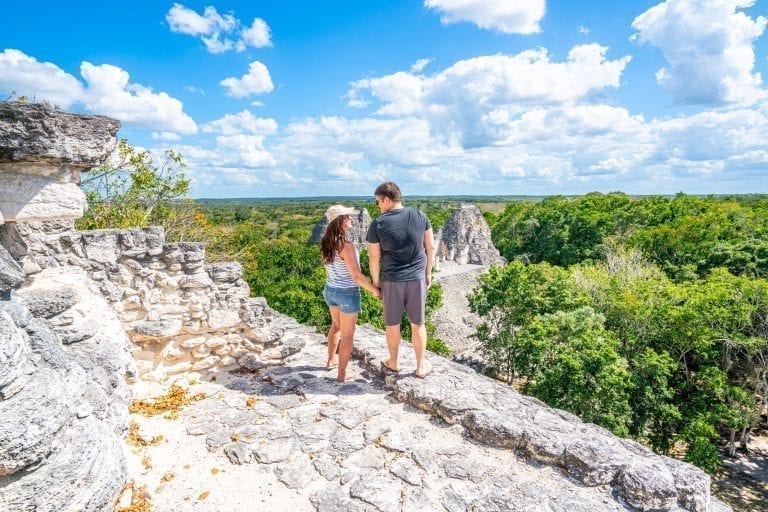
25 Fascinating Ruins in Mexico to Visit (Mayan, Aztec + Beyond!)
From climbing pyramids to learning about life in Mexico hundreds (or even a thousand) years ago, visiting the many incredible ruins in Mexico–with the Mayan and Aztec ruins being the most famous–is a fascinating experience.
Sure, there are world-famous Mexico ruins like Chichen Itza (and they’re certainly worth a visit), but dive off the beaten path, and you may even find yourself alone for moments at a time amongst all the history.
Over our many trips to Mexico, we’ve explored tons of the country’s fascinating ruins, from the mysterious Teotihuacan near Mexico City to the wonderous Calakmul that is hidden deep in the jungle of Campeche.
With every Mexican archaeological site we visit, we learn even more about the history of the great civilizations that have called Mexico home–and also had a lot of fun ascending pyramids, soaking in views, and ducking into historic buildings along the way.
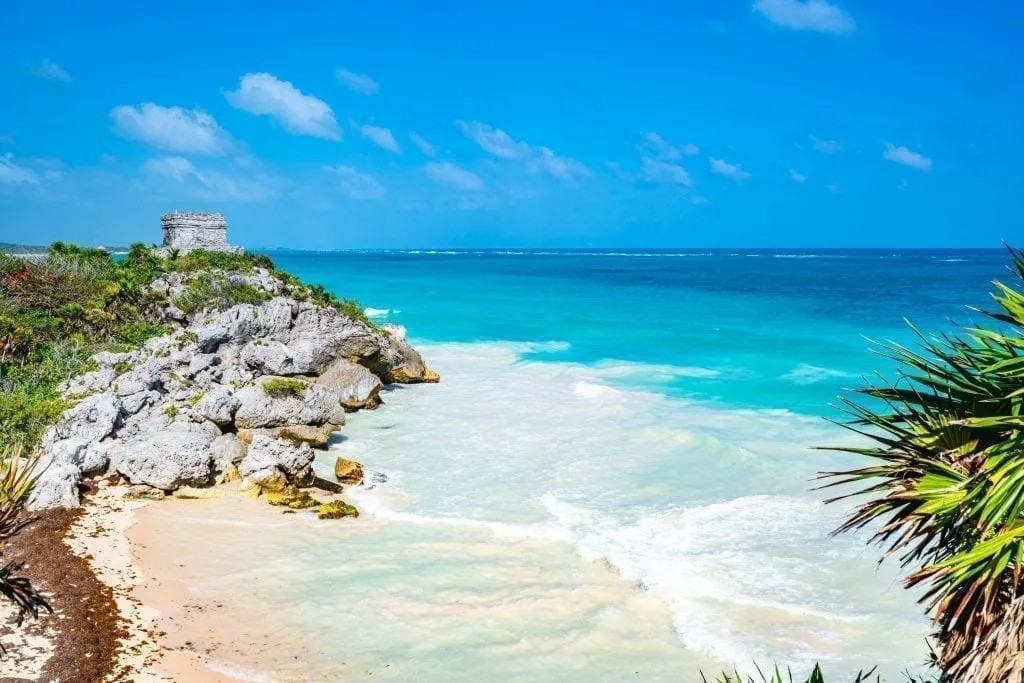
Some links in this post may be affiliate links. If you make a purchase through one of these links, we may earn a small commission at no extra cost to you. Please see our disclosure policy for more detail.
While the Aztec and Mayan ruins in Mexico are often considered the best-known, the modern country of Mexico has been home to many civilizations and indigenous groups over the past millennia, and you’ll see several different cultures and time periods listed here.
For this blog post, we asked several other travel bloggers to share their favorite Mexico ruins to visit with us, and we received quite a range of responses!
From the iconic to the offbeat, here best ruins in Mexico to explore, left behind by the Mayans, Aztecs, and more.
Table of Contents
Mayan Ruins in Mexico’s Yucatan + Quintana Roo
More southern mexico archaeological sites, mayan + aztecs ruins in north + central mexico, map of the best mexico ruins to visit.
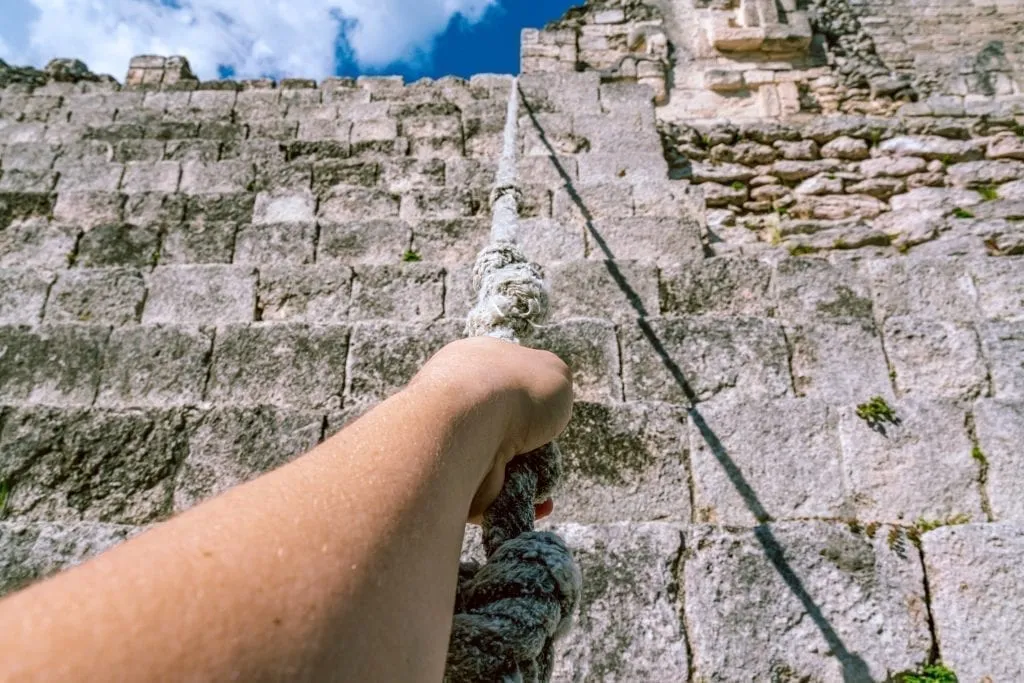
Chichen Itza
From David and Intan of The World Travel Guy
The colossal Mayan ruins of Chichen Itza definitely belong on any Mexico ruins bucket list!
Historically, Chichen Itza was one of the biggest and most important cities of the Mayan civilization.
The centerpiece of this archaeological park is the giant pyramid known as the Temple of Kukulcán (El Castillo).
Even though you can’t climb it anymore, it’s still a spectacular wonder of the world!
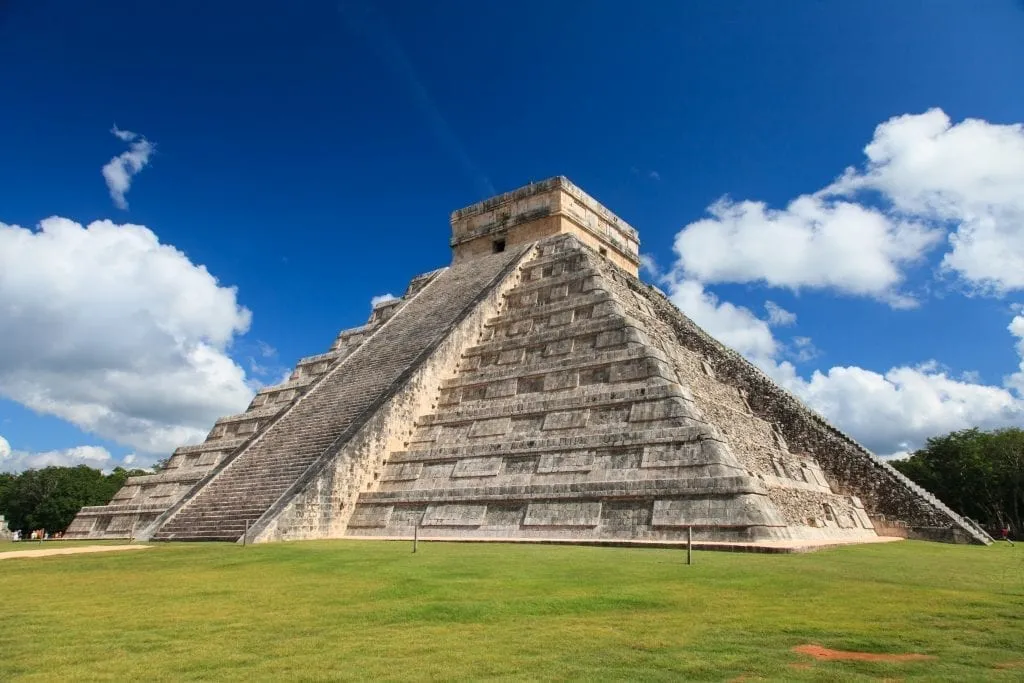
These ruins are located near the center of the Mexican state of Yucatan, at a distance of about 200 kilometers (125 miles) from Cancun.
You can also combine Chichen Itza with a visit to the colonial city of Valladolid and/or one of the many nice cenotes (natural sinkholes) in the area.
For solo travelers, the most economical way to get from Cancun to Chichen Itza is to take the ADO bus.
If you’re traveling in a group, renting a car and driving can also be very cost-effective.
The easiest way to visit Chichen Itza from Cancun (or from elsewhere in the Yucatan peninsula) is to join a group tour or book a private tour.
Where to Visit Chichen Itza From
Chichen Itza is easy to visit from any of the popular Riviera Maya cities like Cancun, Playa del Carmen, and Tulum.
It’s also close to Valladolid.
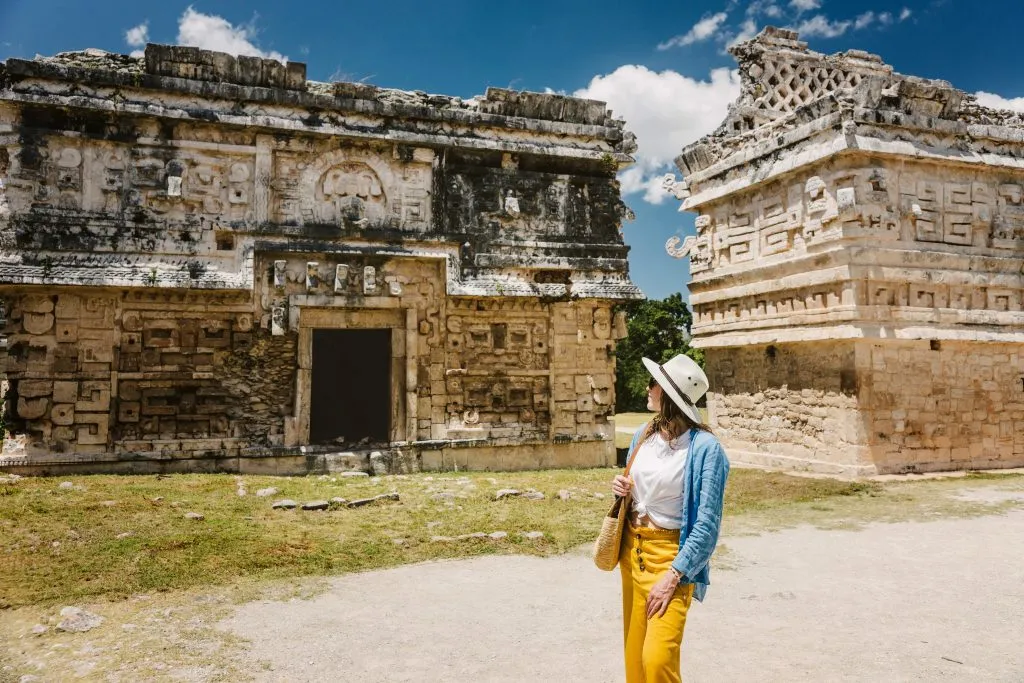
Tulum Ruins
From Allison of Viva La Travelista Located just outside of Tulum’s city center, the Tulum Ruins were originally built as a seaside fortress and are the only oceanfront Mayan Ruins in the Mexican state of Quintana Roo. The most noteworthy feature of the Tulum Ruins is the oceanfront location with the ruins elevated at a height of about 39 feet (12 m) above the water, offering spectacular ocean views.
The site also offers a unique public beach access point where visitors can take a dip in the Caribbean Sea after exploring the ruins. At the Tulum archaeological site, many basic structures and buildings remain including El Castillo (The Castle) and many different temples.
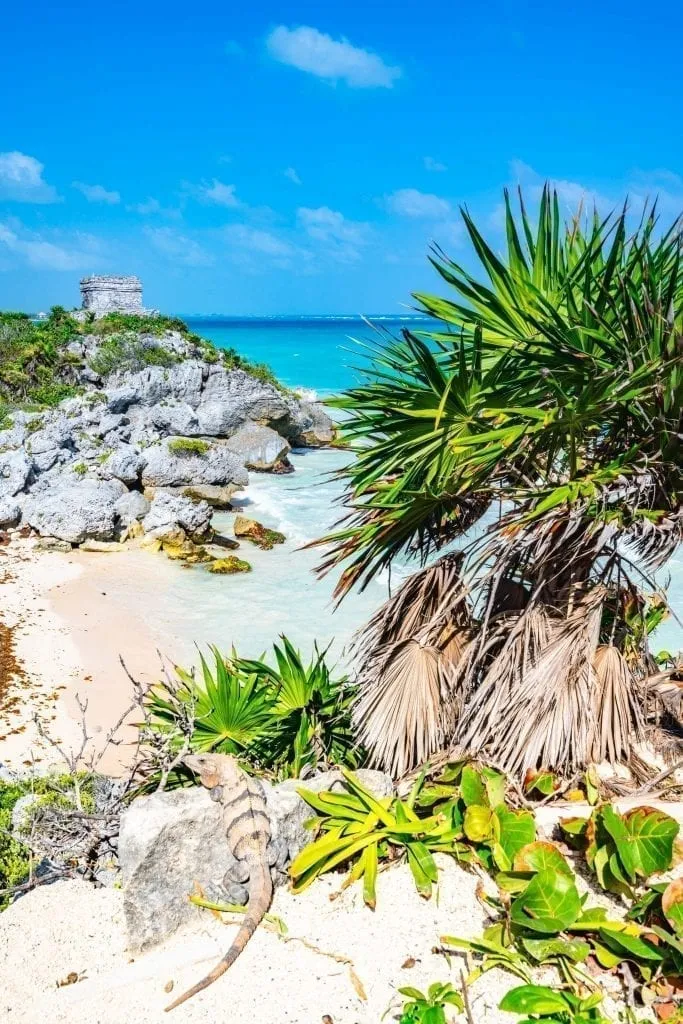
Visitors can explore the ruins at leisure, and learn about the history of the Mayan people.
The ruins are widespread and there is little shade on site so you’ll want to be prepared for the heat and wear comfortable walking shoes. The Tulum Ruins are open daily from 8-5. Located just off the main highway, the ruins can be easily reached by driving or renting a car and paid parking is available on site.
By public transportation, the ruins can also be visited by taking a colectivo (shared van) or the ADO bus from Playa del Carmen or Cancun.
Where to Visit the Tulum Ruins From
Most visitors will be visiting the Tulum Ruins archaeological site from the nearby beach towns of Tulum, Playa del Carmen, or Cancun.
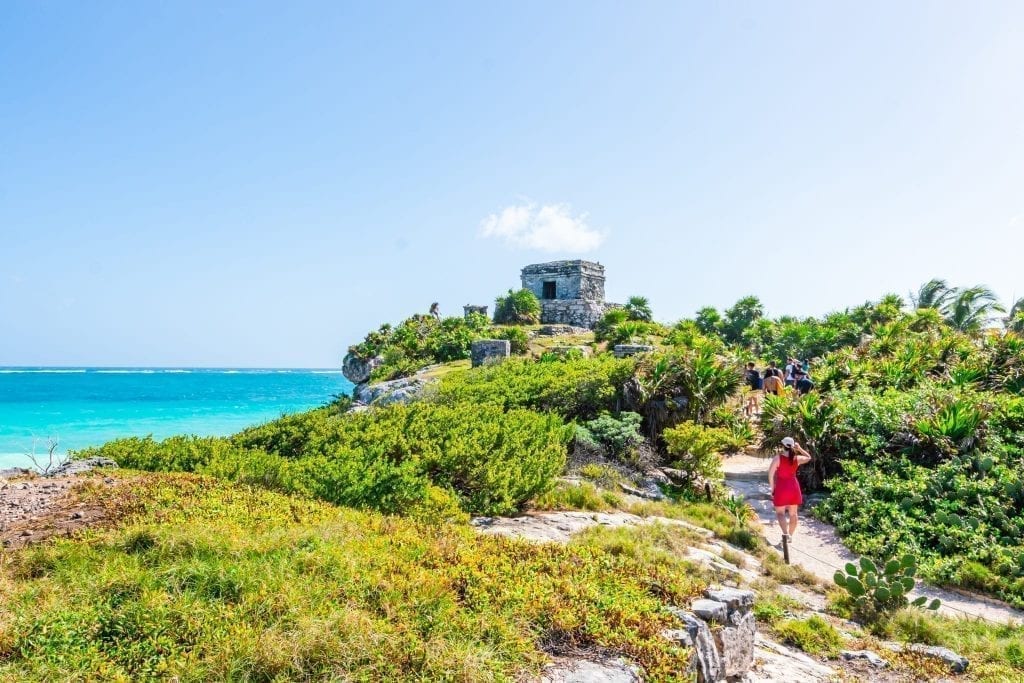
Located near Valladolid, so close to yet so far from crowded Mayan archaeological sites like Chichen, you’ll find the stunning Ek Balam.
Once a thriving Mayan city, construction began on Ek Balam as early as 300 BCE, and the city was potentially occupied as late as the 16th century CE.
It was at its height from roughly 770 to 840 CE, and was the home of around 20,000 people.
Eventually, Ek Balam receded into the jungle, and large pockets of its story remain unknown.
Fast forward all the way to the 1980s, and excavations began in the city.
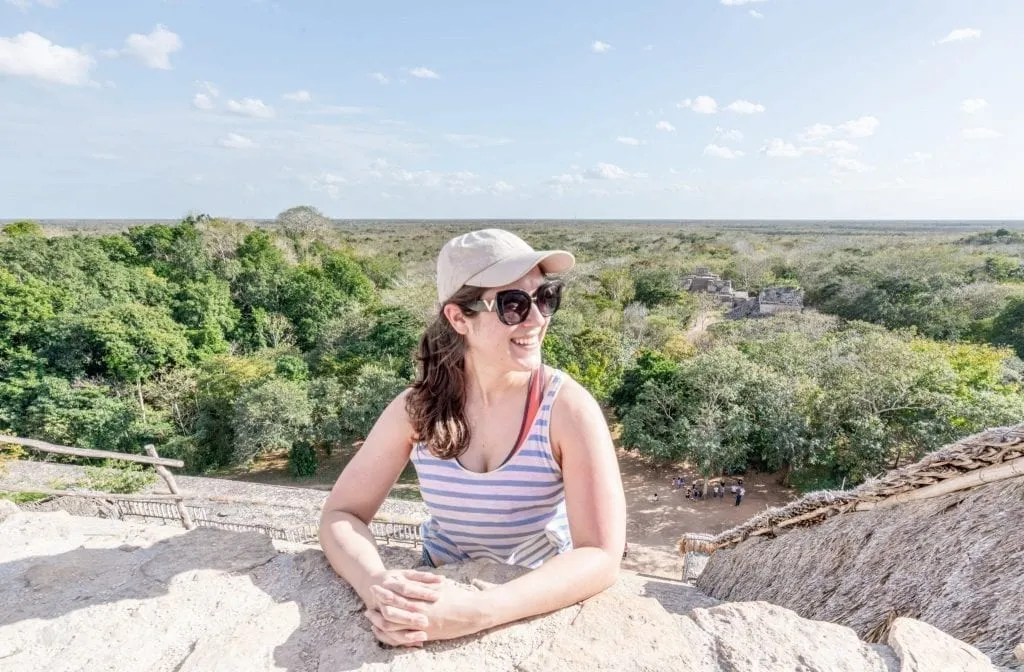
Today, only a small portion (about one square mile) of Ek Balam is excavated, including the impressive El Torre pyramid.
Around 45 structures have been mapped, and around 1 square mile (of approximately 12 square kilometers) of the city can be explored today.
Ek Balam is also home to one of the most stunning cenotes of the Yucatan Peninsula, the incredible Cenote X’canche.
Don’t miss it when visiting Ek Balam!
Where to Visit Ek Balam From
Ek Balam is most commonly visited from Valladolid, but you can reach it from the Riviera Maya as well.
If you’re visiting from Valladolid, the easiest way is to rent a car and drive , but you can also hop in a colectivo or hire a taxi to visit.
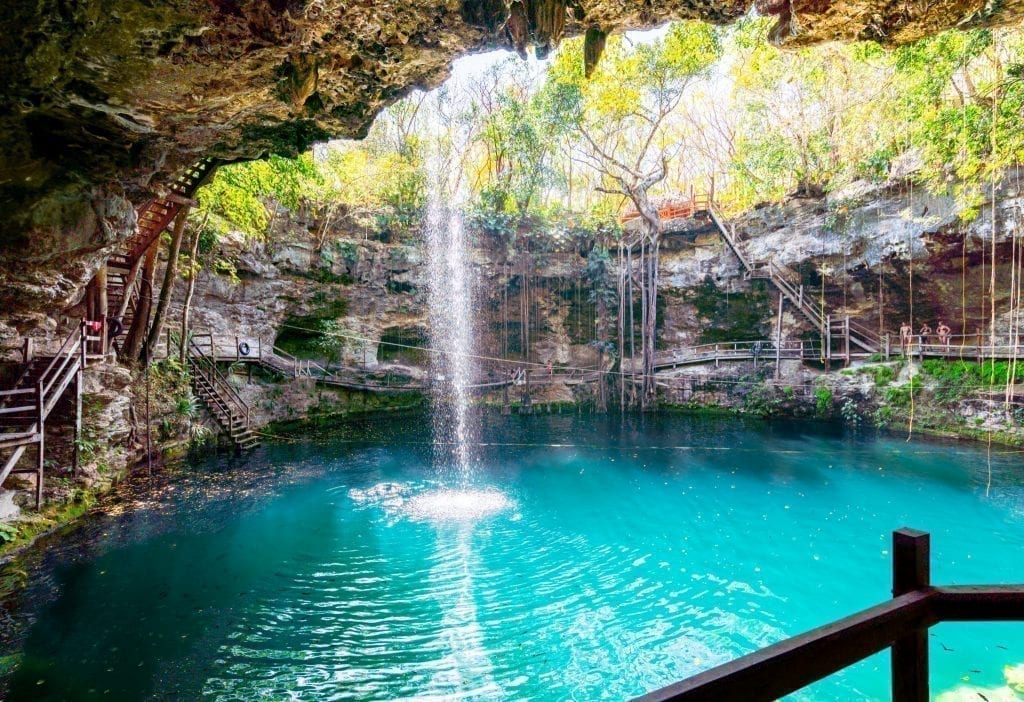
From Brodi of Our Offbeat Life
Kohunlich is a Mayan ruin site 68 kilometers from Bacalar in Quintana Roo, Mexico.
Kohunlich was named after the town nearby because the actual, historic name has been lost to time.
The site is unique and fun to visit because it’s still largely unexcavated. Only about 10% has been unearthed.
Visitors are often treated to seeing archeologists working on excavation areas within the ruins, which is very different from fully excavated sites like Chichen Itza.
Since the ruins are less popular, there are no rules against climbing the ruins. In addition, even if a cruise ship is in port, visitors have a chance of being the only visitors.
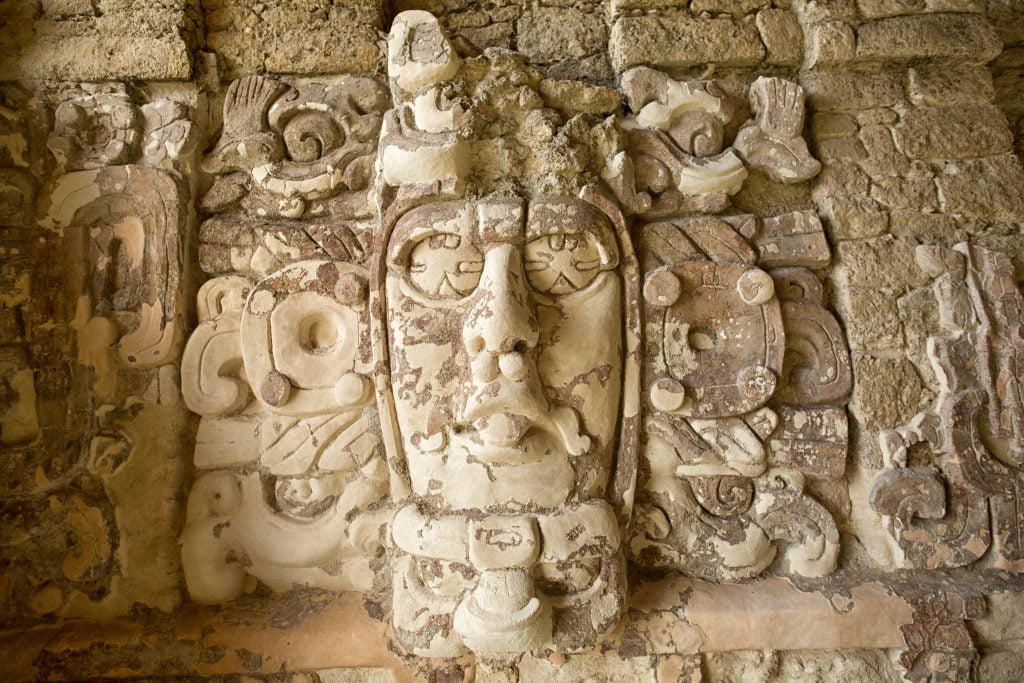
There isn’t a lot of public transportation in southern Quintana Roo, so the only way to get to Kohunlich is to either rent a car or hire a tour.
Regardless of the transportation chosen, take water and snacks.
There are no amenities on-site at the ruins besides a small ranger station and some rustic restrooms.
Where to Visit Kohunlich From
Located just an hour’s drive from Bacalar and two hours from Mahahual cruise port, Kohunlich is a perfect day trip from either Bacalar or the cruise port.
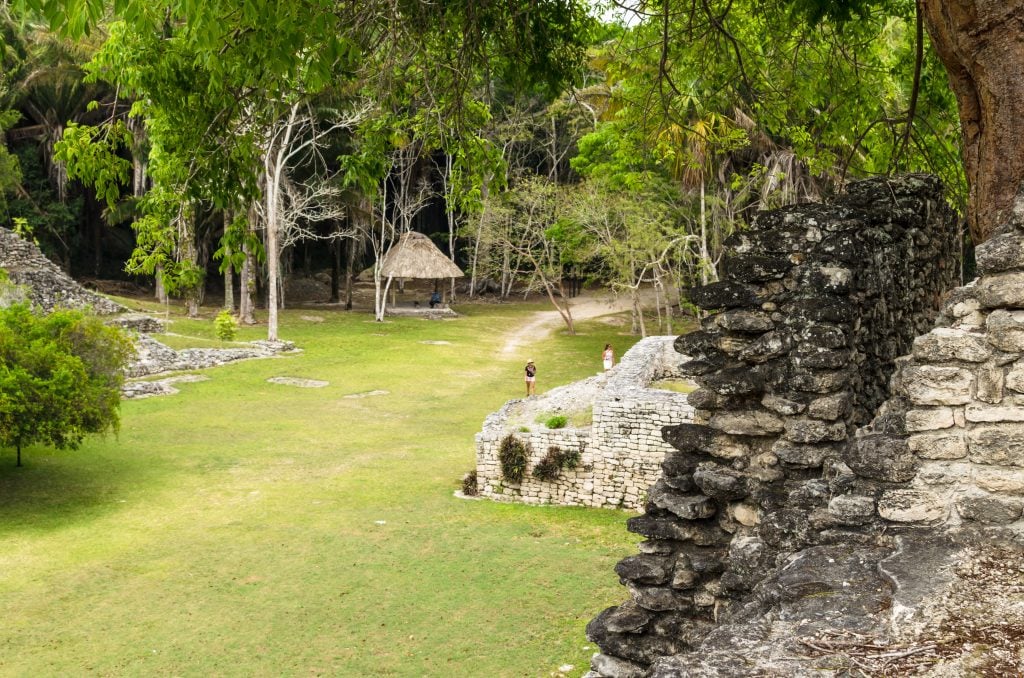
Muyil Ruins
From Shelley of Travel Mexico Solo
The Mayan name of Muyil Ruins is Chunyaxché , though you’ll always see it referred to as Muyil (pronounced moo-yill).
It is an off-the-beaten-path site near Tulum, Mexico , that’s not super easy to get to without a boat tour.
This is why many people skip it, but Muyil really is worth the effort.
Located just south of Tulum in the Felipe Carrillo Puerto Municipality, Muyil is in the Sian Ka’an Biosphere Reserve.
This is a one million-acre protected preserve that’s a recognized UNESCO World Heritage Site.
The easiest, safest, and best way to visit Muyil Ruins is on a boat tour.
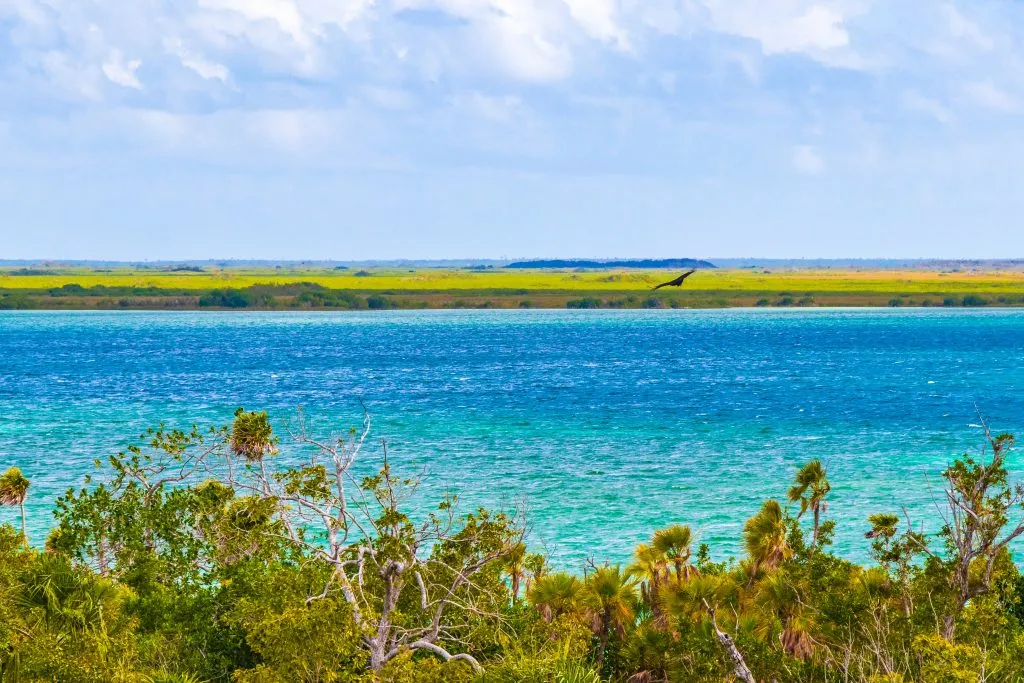
The quicker road to get there takes about 45 minutes, but you need a 4X4. The longer route can be done by car but takes three hours from downtown Tulum.
The boat tours to Muyil are great because you get to go out on the waters of Sian Ka’an, and also visit the ruins.
Sian Ka’an has calm, turquoise waters so it’s a great place to swim, and most people usually see some dolphins while boating.
The Muyil Ruins, though they aren’t too far from the Tulum Ruins, look completely different.
At Muyil, you’ll see a tall, steep pyramid that’s similar to Tikal Mayan Ruins in Guatemala , which has the Peten architecture style.
Where to Visit Muyil From
Muyil is located in Quintana Roo state, near Tulum, Mexico.
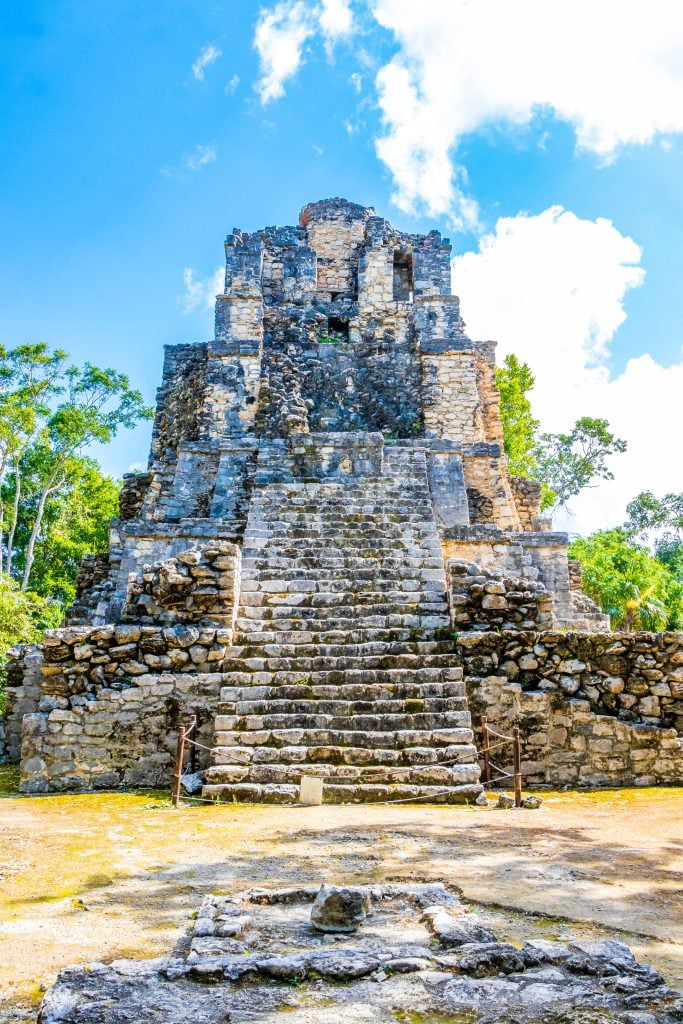
From Karen of Outdoor Adventure Sampler
Uxmal is a stunning Mayan ruin located 50 miles south of Merida in the Yucatan state.
The ancient city is known for its unique structures from the Puuc architectural style.
The carved limestone figures on buildings honor the ancient rain god, Chaac.
The importance of water to the Mayan agrarian people in Uxmal was the basis of the ornate stonework honoring Chaac.
The centerpiece of the restored city is the Pyramid of the Magician, which dominates the entrance to the ruins.
Folk legend has it that a dwarf magician was ordered by the Uxmal king to build the huge pyramid in one night to save his life.
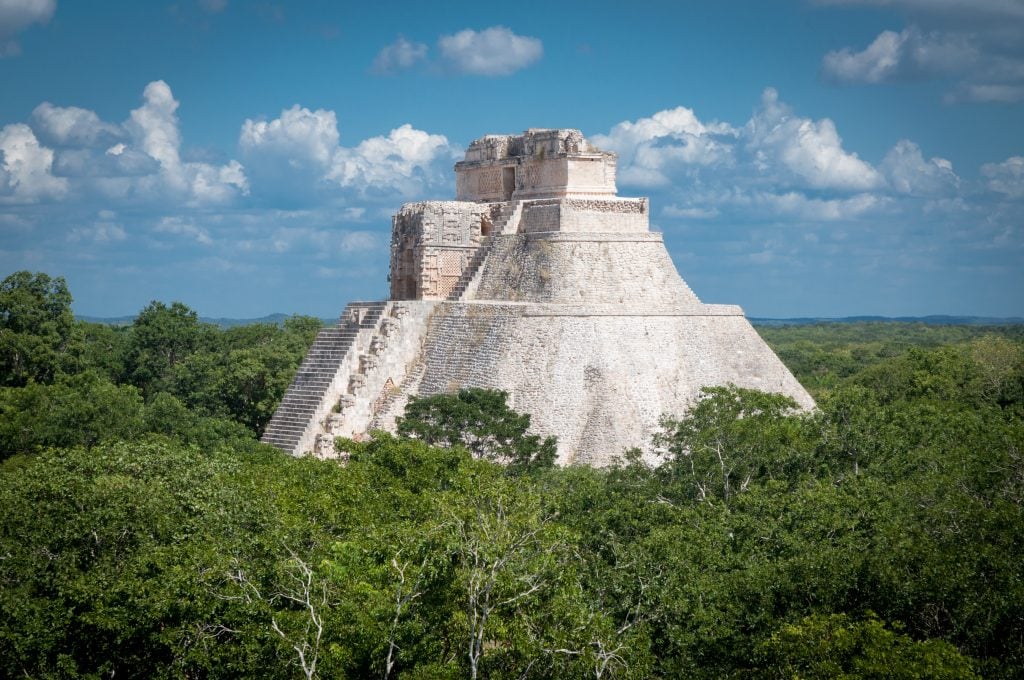
Unlike many Mexican ruins, you can actually climb up the ruins at Uxmal.
Ascend the stone stairs of the Governor’s Palace to get a panoramic view of the many structures of Uxmal peeking out from the jungle. The Pyramid of the Magician dominates the view.
Uxmal is a UNESCO World Heritage Site and one of the outstanding outdoor adventures of the Yucatan .
It’s less crowded than the neighboring Chichen Itza ruins. Visit in the morning before it gets steamy and hot, with fewer visitors to encounter too.
Where to Visit Uxmal From
Uxmal is about an hour’s drive south of Merida, the capital of the Yucatan state.
There are many tours from Merida to Uxmal or you can rent a car in Merida and drive.
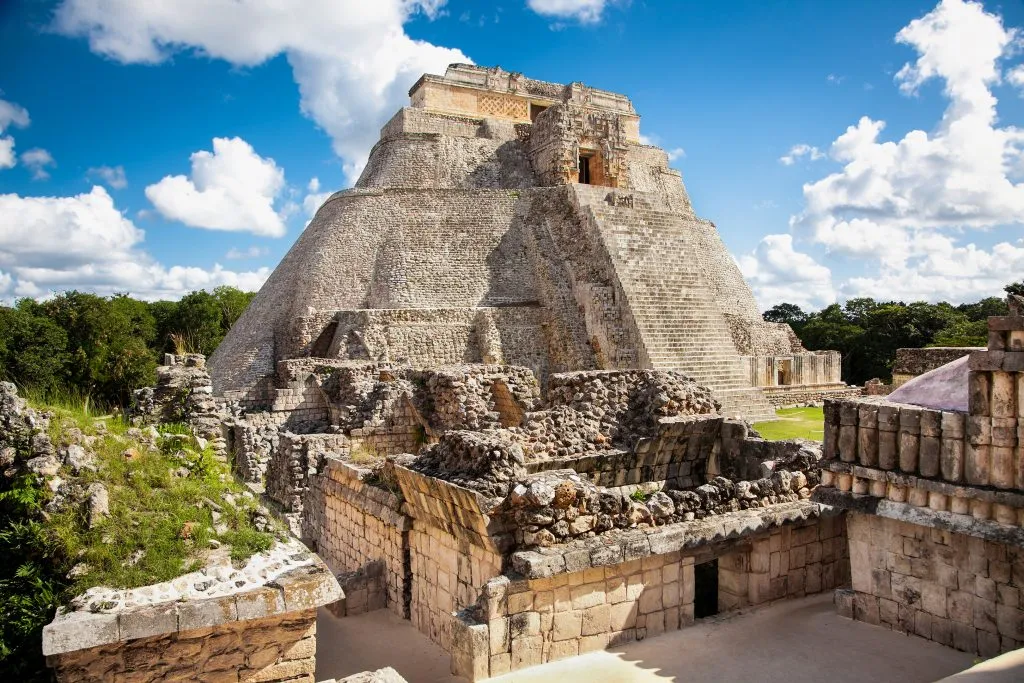
Located in the small town of Xpujil, Becan is one of the most underrated ruins in Mexico to visit (and so far, our personal favorite).
Once a thriving capital city of the Rio Bec province, Becan was a powerful force in its region, featuring a moat surrounding the city, powerful structures built over many centuries, and sprawling plazas.
While the oldest structures in Becan date to as early as 500 BCE, its moat and surrounding walls were constructed somewhere around 100 AD to 250 AD, and the bulk of the more impressive structures were built even much later than that–starting around about 550 AD.
That’s a bit dizzying to imagine, considering we’ve already covered around 1000 years of history there, but Becan was just getting started.
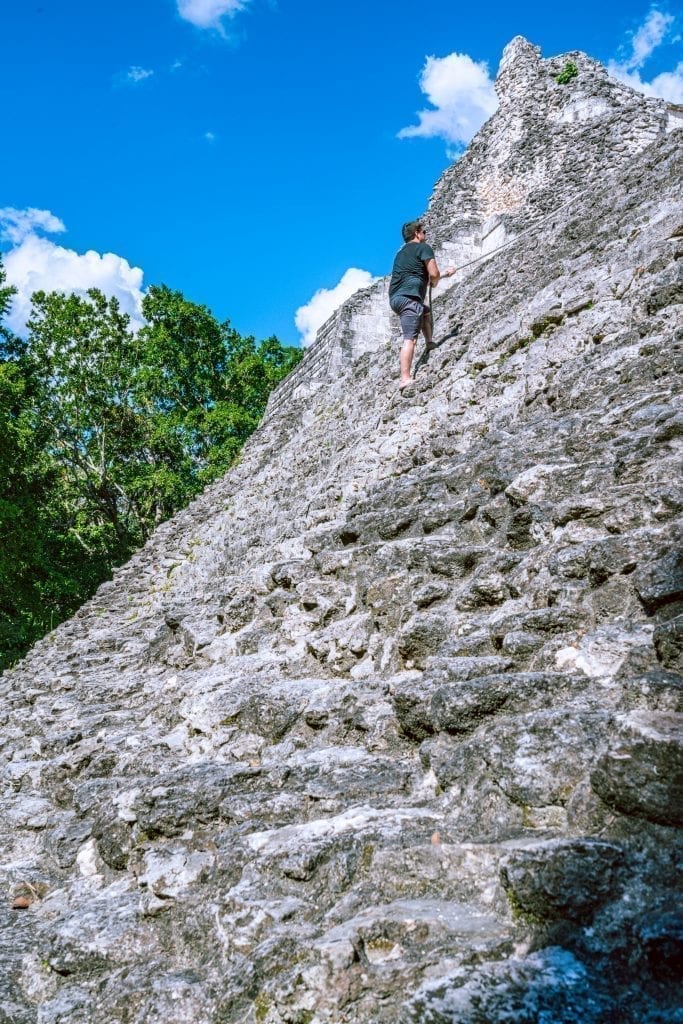
It thrived from around the 7th to the 12th centuries, more or less, before the city was eventually abandoned around 1200 AD.
Today, 20 structures have been excavated and are open to visitors, and the size and scale of the city are incredible to imagine when standing in the center of it.
Today, wandering the impressively well-preserved city is a magical experience, greatly enhanced by the fact that it is extremely uncrowded.
Where to Visit Becan From
The Becan ruins are located in Xpujil, about 90 minutes north of Bacalar, and the route makes for an incredibly easy drive , with most of it taking place on the Mexico 186 highway.
If you’d rather not take a day trip, you can spend the night nearby and use the area as a launching pad for visiting Calakmul as we did.
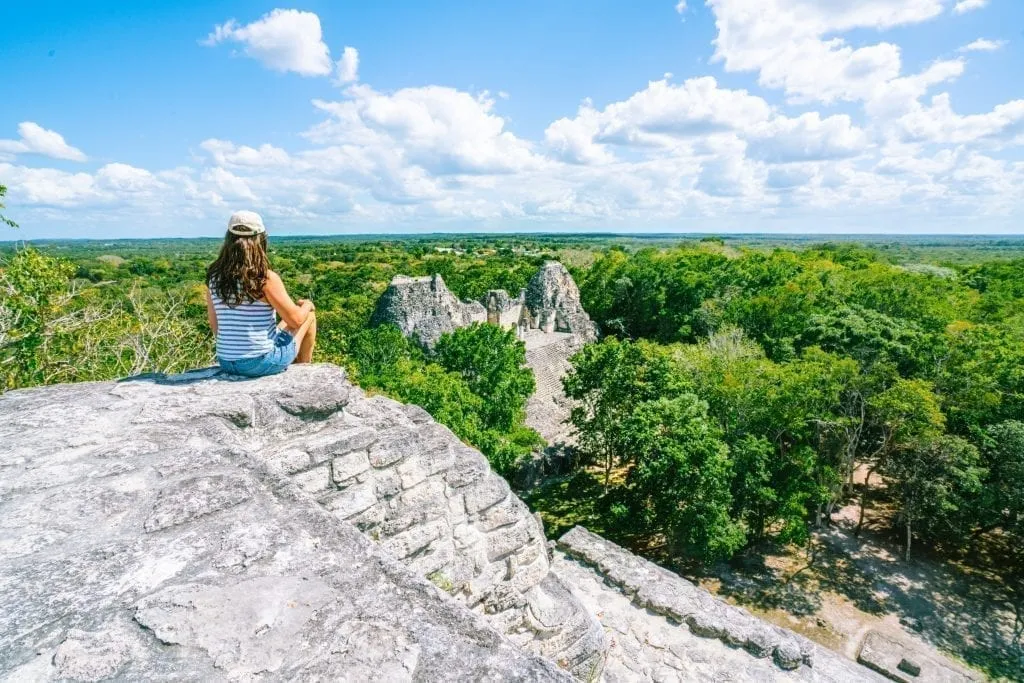
Dzibanche and Kinichna
From Daria of The Discovery Nut
Located in Mexico’s Costa Maya region , Dzibanche and Kinichna are two of the most remote Mayan ruins in Quintana Roo.
The two archaeological areas are located next to each other and require a drive on the bumpy road.
Since there is no public transportation to Dzibanche and Kinichna, you can only visit them with a car rental or a guided tour.
Keep in mind that this area is truly remote. There are no stores, gas stations, or restaurants in the area and after you pass a few small villages on your way to the ruins, your cell phone service could disappear.
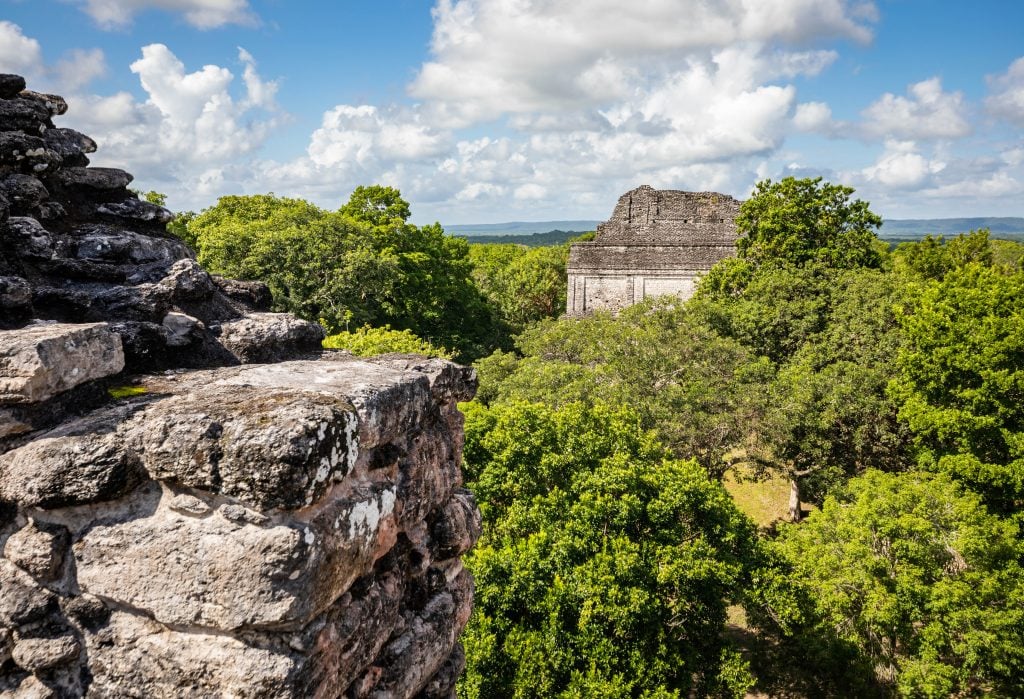
The ruins are visited by no more than a dozen people daily, and it’s not uncommon to have this entire area all to yourself, especially if you come here in the morning.
When you arrive at the site, you will pay a cash fee of 70 Pesos that covers both sites and will enjoy a relaxing walk in the jungle while exploring some of the coolest Mayan ruins where few other tourists venture.
This is a really fun experience that makes you feel like you’re exploring off the beaten path, which you will not have at more popular Mayan ruins in the Yucatan Peninsula.
Since these two ruins are separate, you will need to take a quick drive from Dzibanche to Kinichna which is about 2 kilometers away.
Where to Visit Dzibanche and Kinichna From
The closest city to Dzibanche and Kinichna is Bacalar, but many travelers also visit these archaeological areas from Mahahual, a popular stop for cruise ships in Costa Maya.
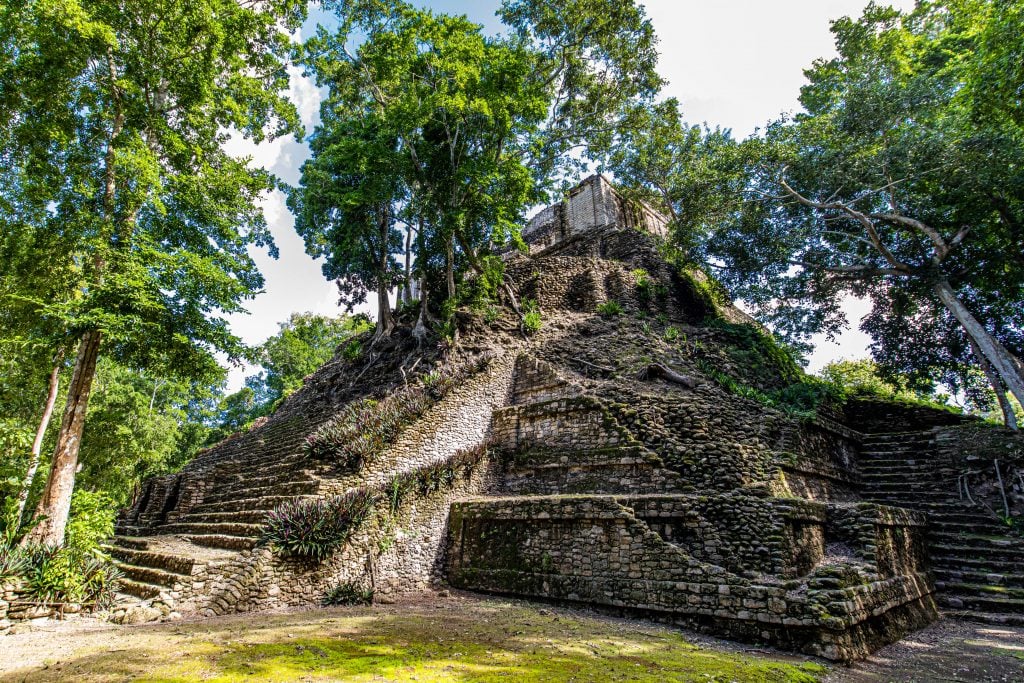
From Yulia of Miss Tourist
Thought to have been utilized between 1250 and 1630, the site of El Ray was not only an extremely important part of the Mayan trade route but also a town utilized as a retreat for the royals.
It was after findings of royal belongings were made in the area that the site was named El Rey or “the King”.
Located at the southern end of Cancun island, right in the center of the hotel zone, at first sight, the remains of El Rey may not seem too impressive, however, it is much more than its convenient location which makes this site worth seeing.
Firstly, while it is located in the heart of one of the busiest areas of Quintana Roo, El Rey provides a welcome respite from the noise as this is one of the more seldom frequented attractions by the mass of tourists who visit the city each year.
Although there are not many full structures still standing today, you can clearly see the outline of where many different buildings once stood.
You can also see two small structures which are believed to have been used as lighthouses or watchtowers.
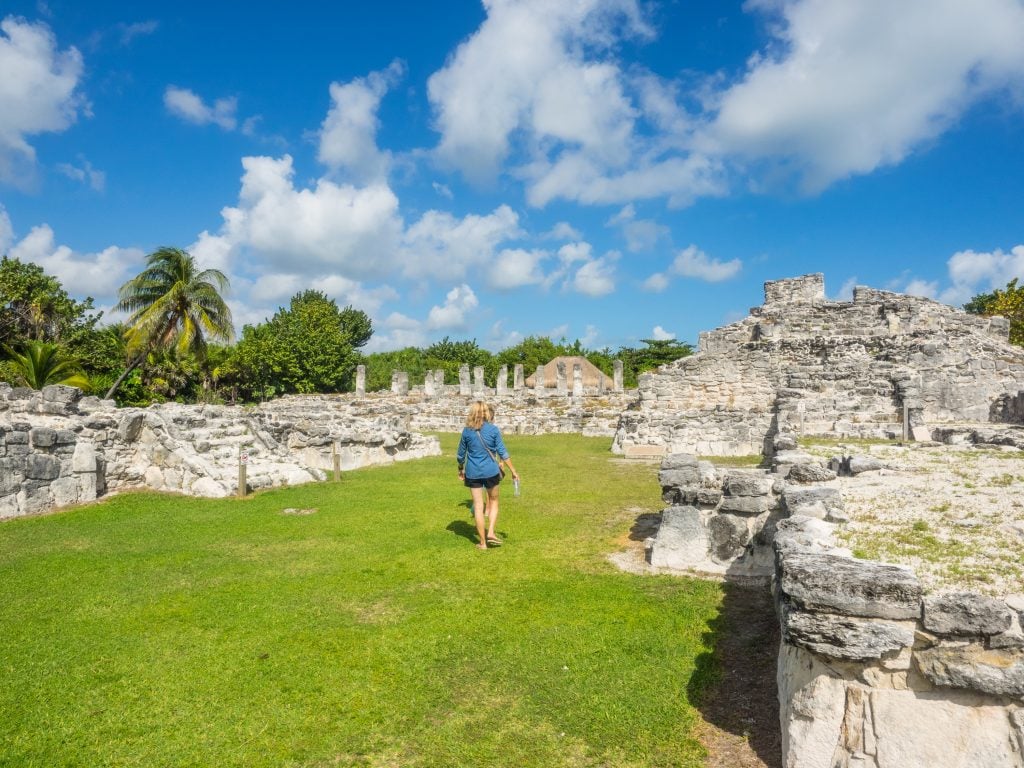
But the real star of the show here is the iguanas. Dozens of these interesting animals call El Ray home, roaming the ruins and claiming this royal playground as their own.
They make for a good addition to photos and are a cool additional site to see!
Entry to the El Ray ruins costs 55 Mexican pesos (about $2.50) and can be found at KM 18 of the Hotel Zone, reachable by bus, taxi, or rental car via the R1 or R2.
Where to Visit El Rey From
Located amongst some of the best resorts in Cancun , in the heart of the hotel zone, El Rey is easily combined with the many activities the city has to offer.
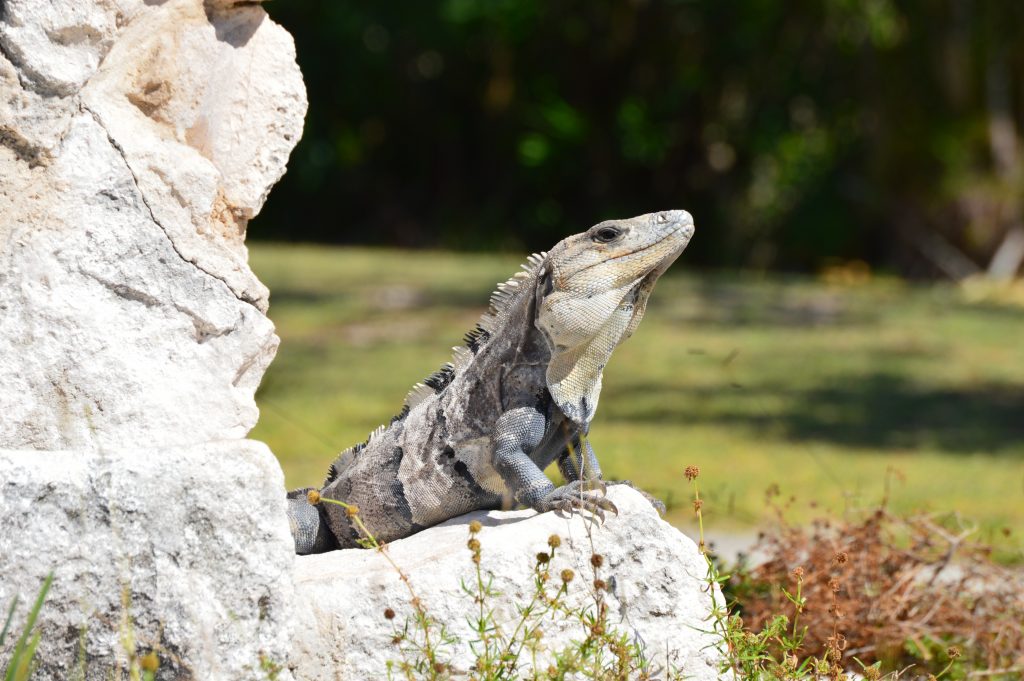
Dzibilchaltun
From Shelley of Travel to Merida
Dzibilchaltún (pronounced zee-bee-shall-tune) is the closest Mayan archaeological site to Merida, Mexico.
With this great location, it’s also one of the best things to do in Merida , especially for travelers who want to experience real Mayan culture.
The main structure is called the Temple of the Seven Dolls (also known as the Temple of the Sun).
You can’t climb the steps of this temple, but there is another pyramid and a few smaller structures you may climb, all located at the back of the site near the cenote (sinkhole).
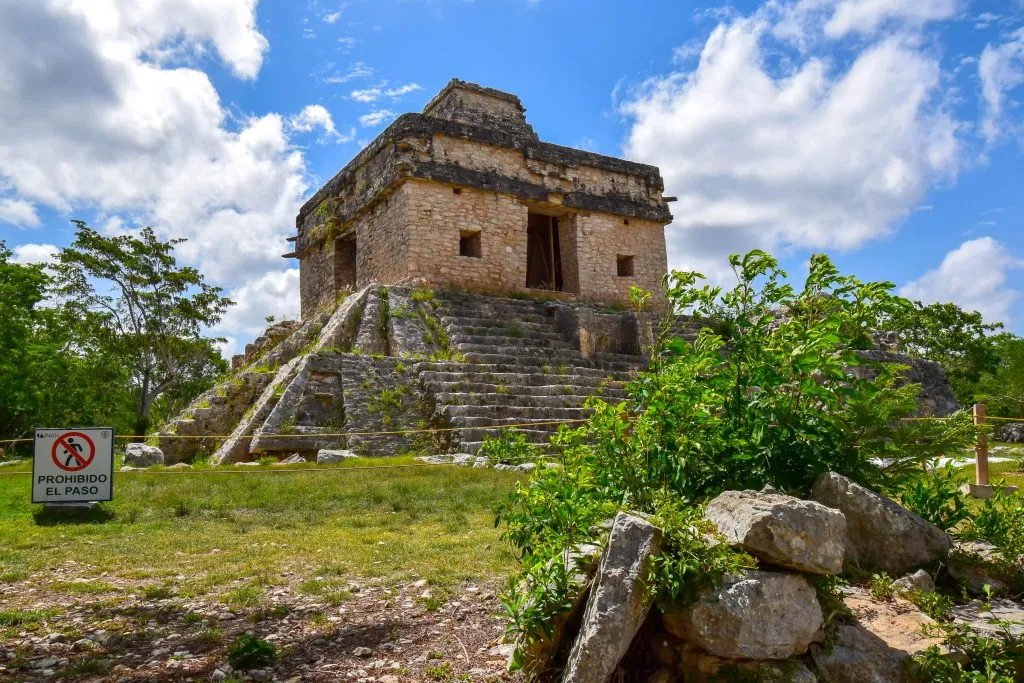
Besides the ruins, there’s also Cenote Xlacah at Dzibilchaltún Ruins you can swim in.
Don’t forget to bring a bathing suit when you visit because going for a refreshing swim after a long day of climbing ancient pyramids is the best way to cool off — and something you can’t do at most other ruins in Mexico.
There’s also a museum at Dzibilchaltún, the Museo del Pueblo Maya de Dzibilchaltún, with large Mayan artifacts found at sites all over the Yucatan.
Just outside the museum, there’s a small sculpture garden with even more statues and pre-Hispanic artifacts to see.
Where to Visit Dzibilchaltún From
Dzibilchaltún Ruins is located in Yucatan state, near Merida, Mexico.
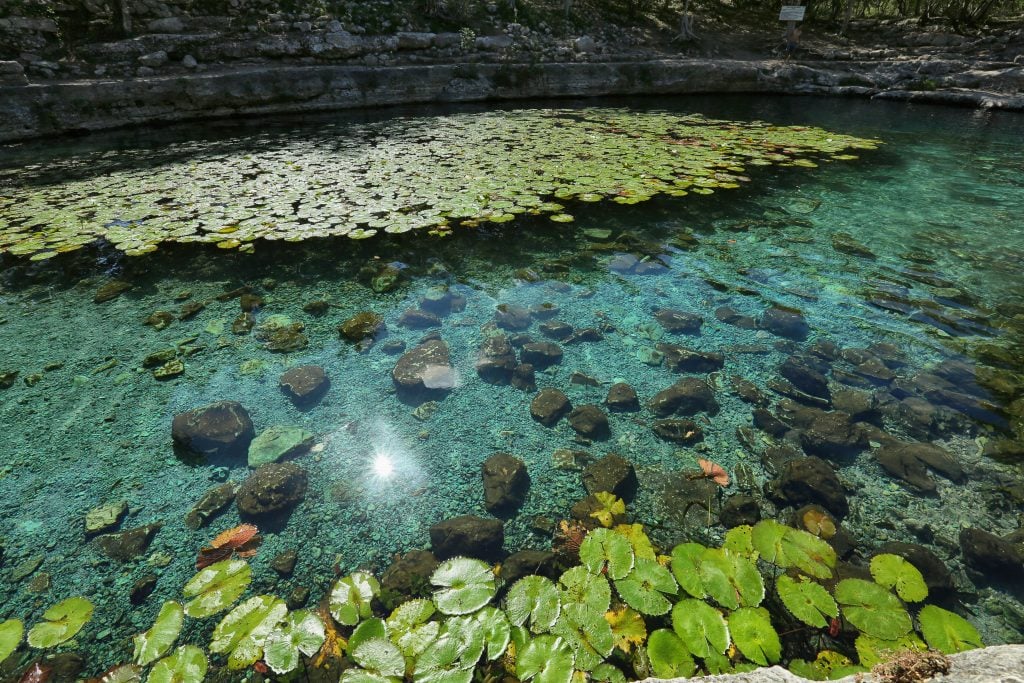
From Isabella of Let’s Travel to Mexico
The archeological site of Coba is one of the most spectacular Mayan ruins in the Quintana Roo State.
The site is one of the more fun to visit but also one with the most interesting history.
You can get there by local busses or by car, although renting a car would also allow you to visit the amazing nearby cenotes.
Once you are at the site you have the options to walk along the old Sacbe (white roads) that lead you to the groups of temples, or you can rent bikes or take a taxi bike.
Keep in mind that it is an extensive area so you would want to consider a 2 to 3 hours visit depending on how fast you are.
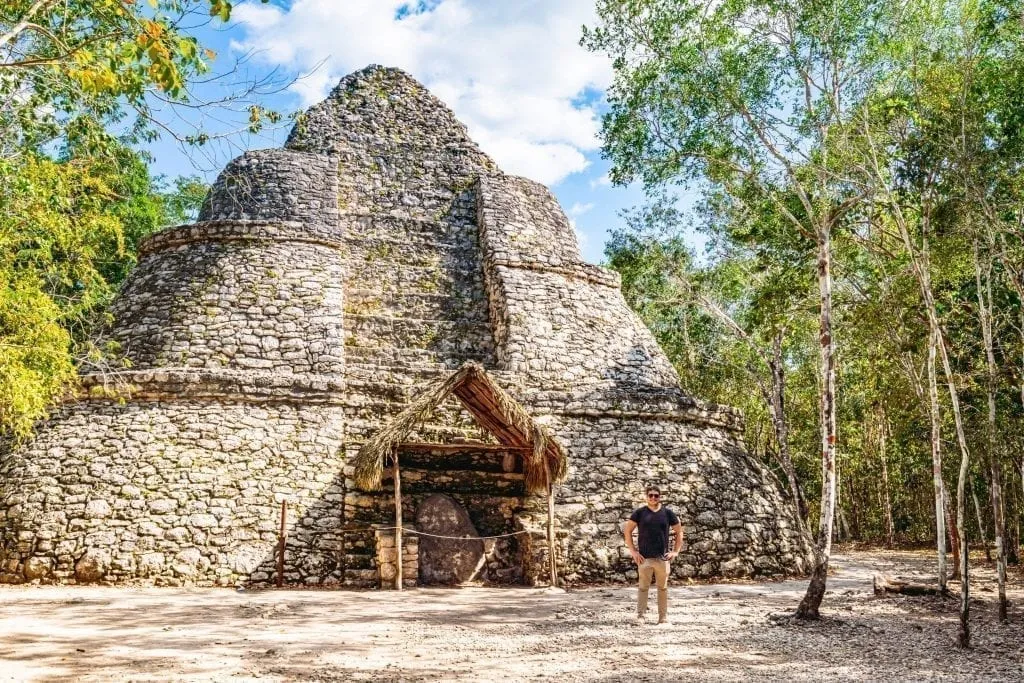
Among the highlights of Coba, you can appreciate the network of roads that connects Cobá both internally and externally to the other Mayan cities.
Also, note the many stelae that have been found and the 42-meter-high Pyramid of Nohoch Mul.
Located just a 45-minute drive from Tulum, it is one of the top places you should visit if you are in the area.
Note from Kate : If you visit Coba and discover that Nohoch Mul can be climbed again, please let us know in the comments below! We loved climbing the pyramid in early 2020 but understand that it has been closed off since shortly after our visit.
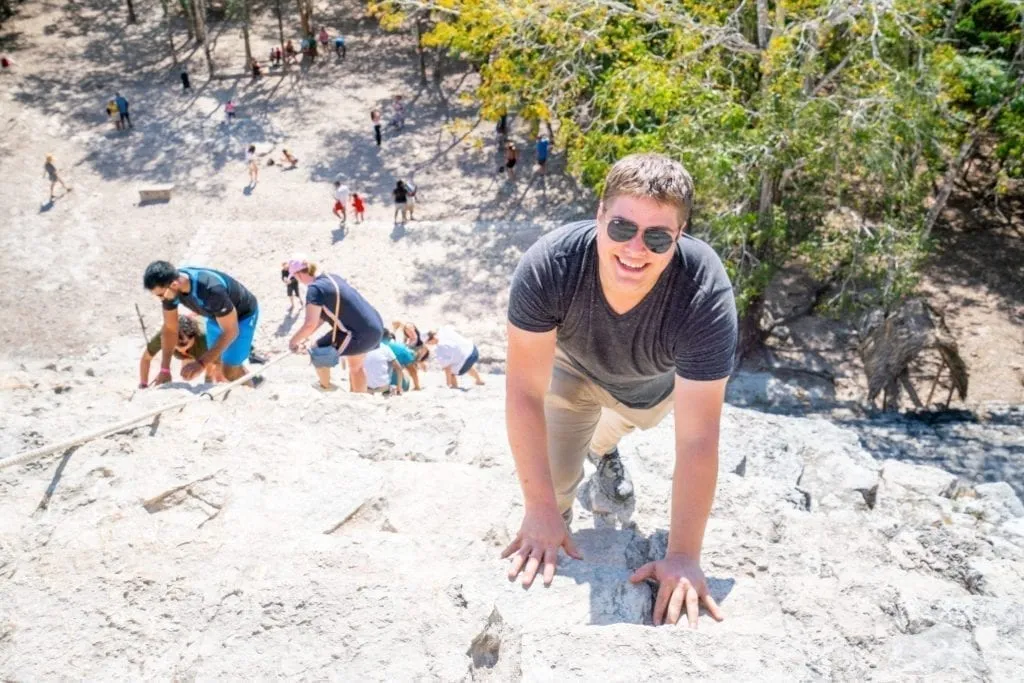
San Miguelito Ruins and Mayan Museum
From Kenny of Knycx Journeying
The Yucatan Peninsula has no lack of pristine beaches, heritage sites, luxurious resorts, and soothing sunshine.
Most of the tourists come here for Chichen Itza , one of the New 7 Wonders of the World.
To be better prepared for the excursion and learn more about the Mayan history and culture, head first to the Mayan Museum which is located in the city of Cancun and built on a Mayan ruin, San Miguelito.
The museum opened in 2012 and it is located on Kukulcan Boulevard.
The building is designed by Mexican architect Alberto Garcia Lascurain, covering an area of eight hectares of area with three key exhibition areas.
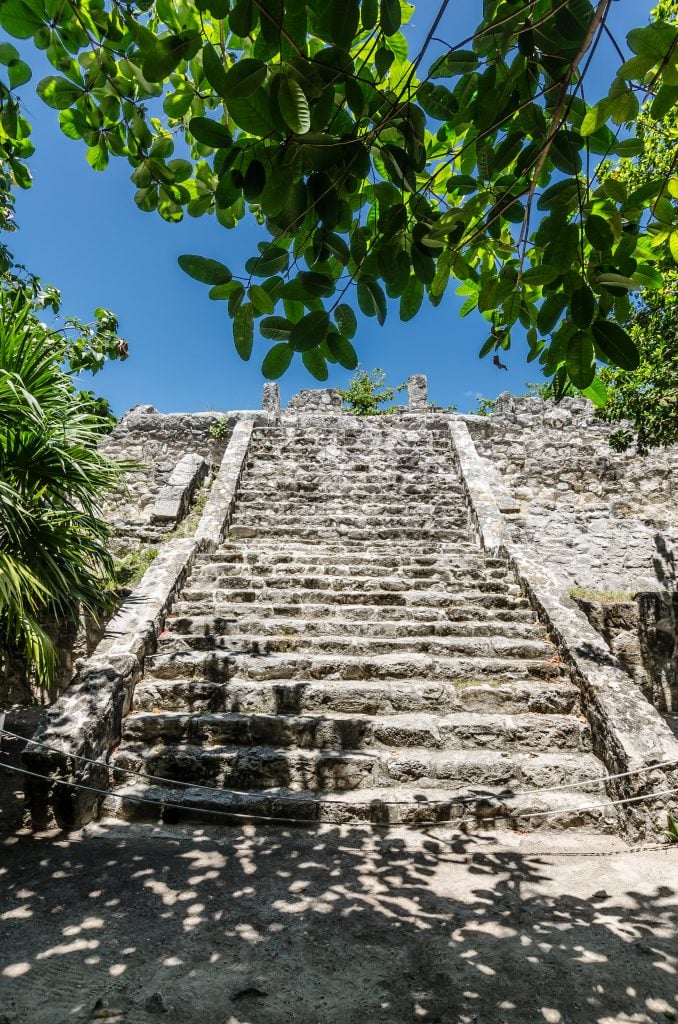
The display showcases an impressive collection of Mayan archaeological artifacts collected from Chichen Itza, which shed light on the lives of the Mayans in ancient times.
Signature items include the state of Quintana Roo, La Mujer de las Palmas (a 12,000-year-old skeleton discovered in a cenote near Tulum), plus valuable potteries, beaded jewelry, funerary masks, and monuments from a number of Mayan sites.
Another highlight is the archaeological site of San Miguelito at the back of the museum. It was actually a former vibrant Mayan port that connects to the Caribbean Sea.
The port was abandoned during the invasion of Spanish Conquistadors in the 16 th century.
Today, visitors can still see the remnants of residential housing, a temple, and an eight-meter-high pyramid.
Where to Visit San Miguelito From
San Miguelito and the Mayan Museum are located in Cancun.
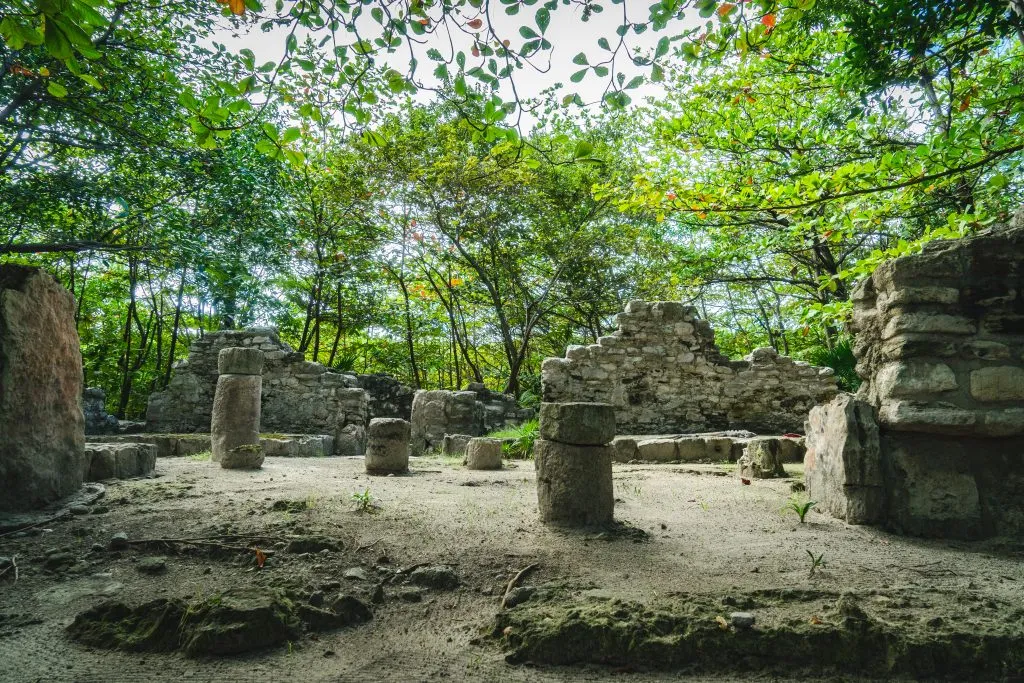
From Ruby of A Journey We Love
Chacchoben is one of the most visited Mayan ruins in Mexico, thanks to the cruise ship guests who visit the ruin as a Costa Maya shore excursion .
Chacchoben is located in the south Quintana Roo province of Mexico.
Within a quick trip away is the 7 Colors Lagoon of Bacalar, and it is part of the Sian Ka’an Biospheric Preserve.
This is one of the ruins in Mexico that still allow guests to climb up and explore.
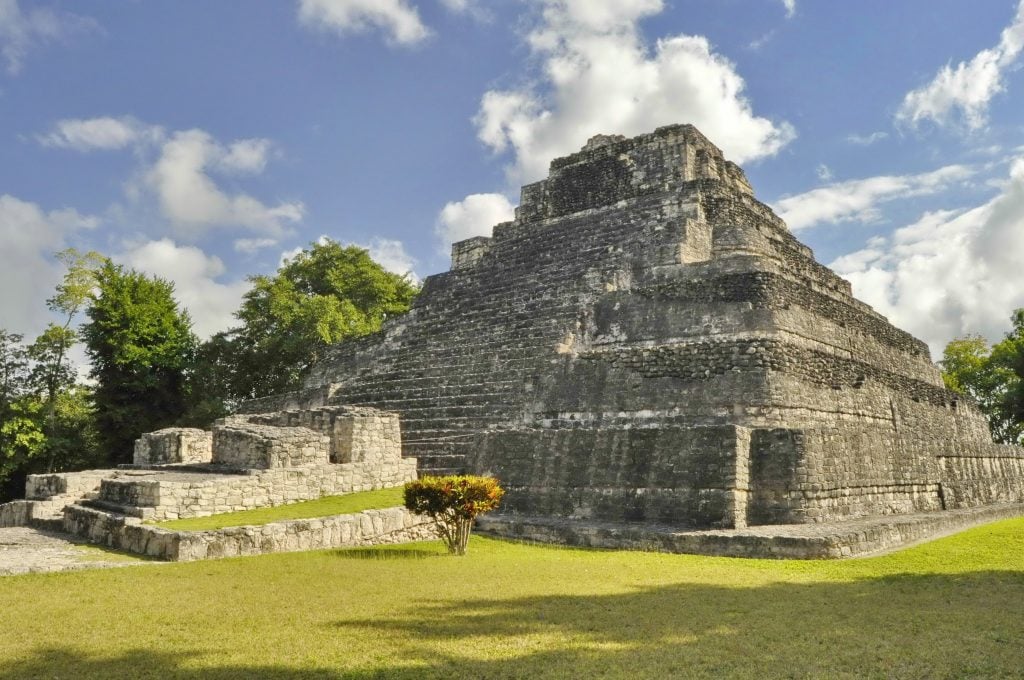
Not much is known about Chacchoben, except that it was abandoned and occupied multiple times, and that the earlier settlers arrived in 1000 BC.
Climbing up to the top of the main ceremonial hub of Gran Basamento, one can see the jungle that surrounds the area, and you may even be lucky to see an animal or two.
Where to Visit Chacchoben From
The closest city you can base yourself in is Chetumal if you opt to fly in.
There are no public transportation options available, so you will have to rent a car to get around.
Alternatively, if visiting on a cruise ship, the closest town is Mahahual, also known as port Costa Maya, which serves as your main base for shore excursions in the area.
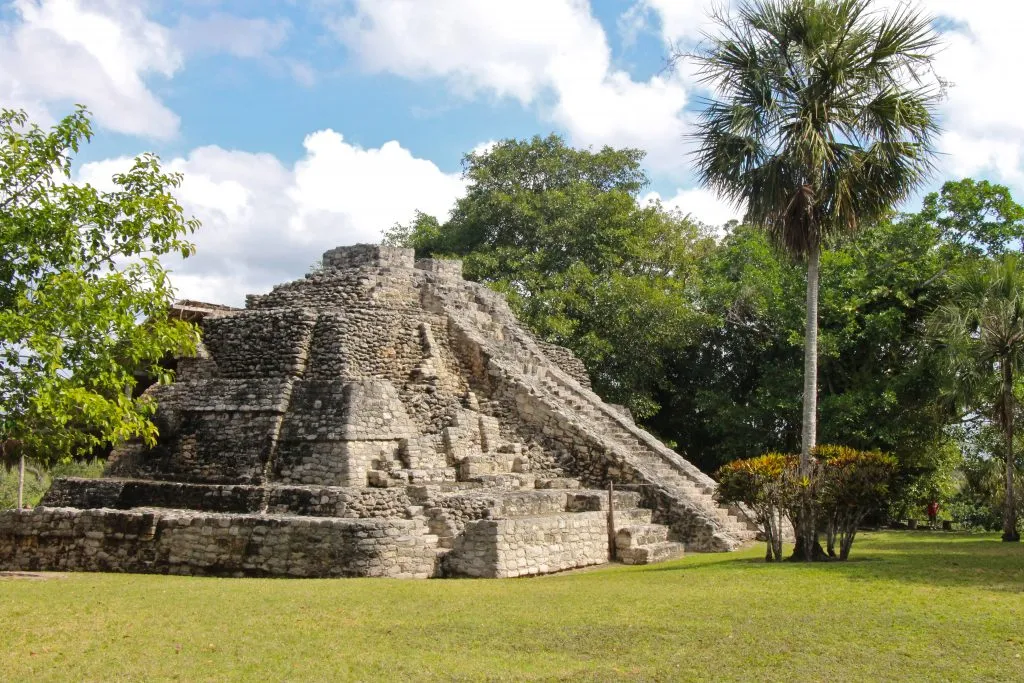
From Isabella of Mexico Cenotes and Ruins
Located on the Riviera Maya, the Xel-ha ruins may be confused with the more popular Xelha Amusement Park –but the archaeological site is a completely different place and experience.
Unfortunately, almost nobody knows about this little and yet precious archeological site, another important ancient Mayan city, and yet it makes an interesting visit if you are staying in the area.
The old Mayan city of Xelha used to be one of the most powerful ports on the Caribbean coasts, of strategic importance.
Nowadays little has been left to visit, but you can still appreciate the murals, some building details, and the natural surroundings.
There is also a cenote that you can visit, the primary source of water in the ancient civilizations, but you can’t swim in that one.
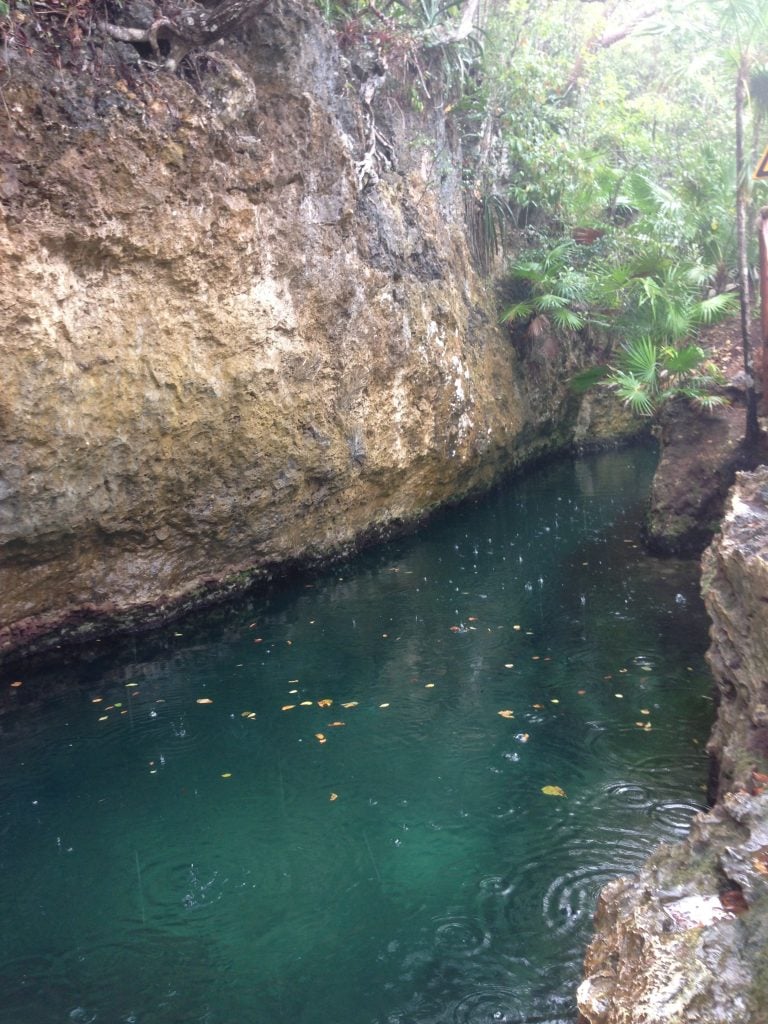
Xel-Ha means “water inlet”, which clearly refers to the geography of the place as where is now the Xel-ha amusement park, was a group of natural canals where the boats would come in.
The Mayan name of the site means Xel, “piece or entrance”, and há means “water”.
Where to Visit Xel-ha From
Getting to Xel-ha is very easy as the entrance is right on the Federal highway that connects Playa del Carmen with Tulum.
So if you didn’t rent a car you can easily get there by the collectivo (small vans) the most popular public transportation used by locals. Just ask the driver to stop at Xelha ruins (not the park).
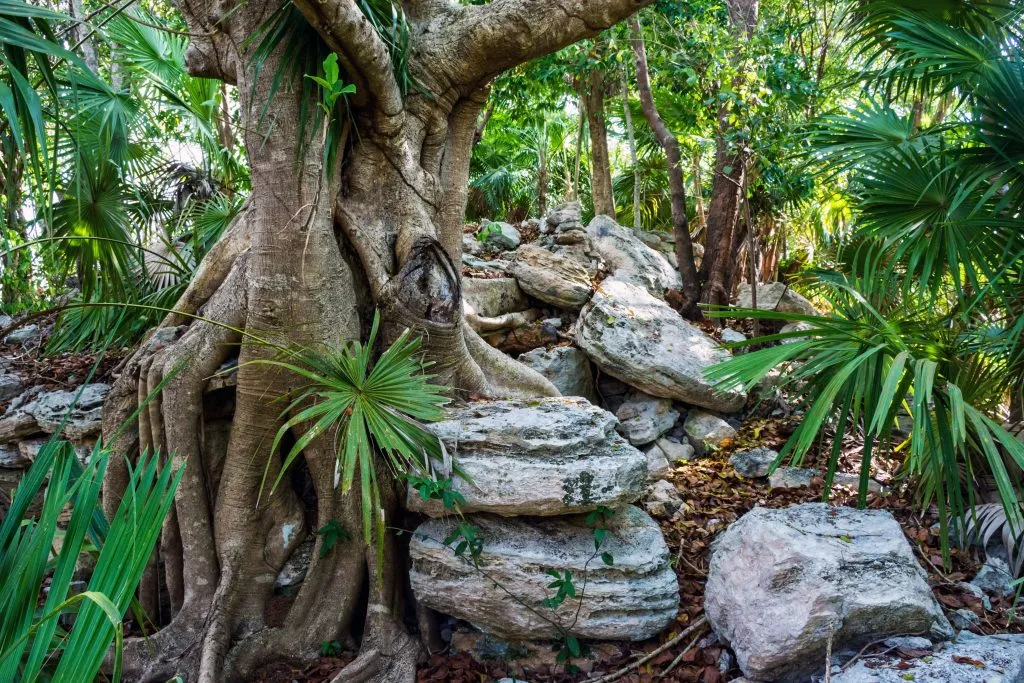
Monte Alban
Dating from 500 BCE, Monte Alban is one of the earliest cities to be recorded in Mesoamerica, and was the largest cultural center of the Zapotecs (though they weren’t the only people to inhabit the city).
Monte Alban was populated until around 850 CE, and therefore offers nearly 1500 years worth of history to share!
Set just outside of modern Oaxaca City, visiting Monte Alban is a fantastic experience that is packed with structures to explore (including the ceremonial area, which is well preserved), as well as views of the surrounding mountains to enjoy.
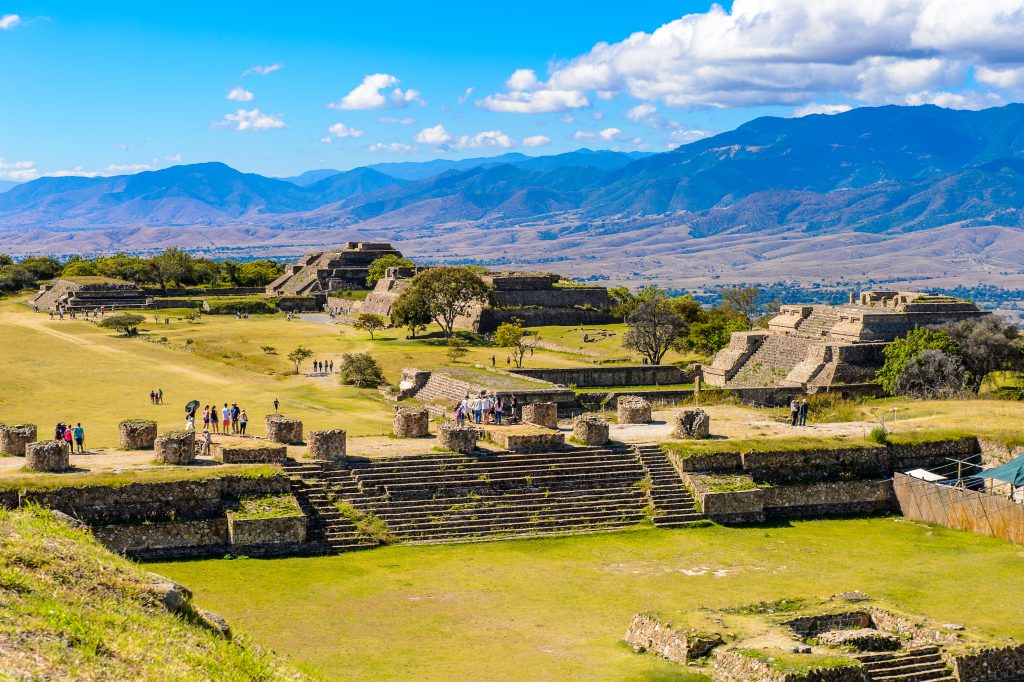
Monte Alban is conisdered the best-preserved and most important Mexican archaeological site in the Oaxaca Valley, and visiting is one of the indisputed best things to do in Oaxaca !
Where to Visit Monte Alban From
As Monte Alban is located only about 6 miles east of modern Oaxaca City, you can easily visit independently by bus.
However, you can book guided archaeological tours as well.
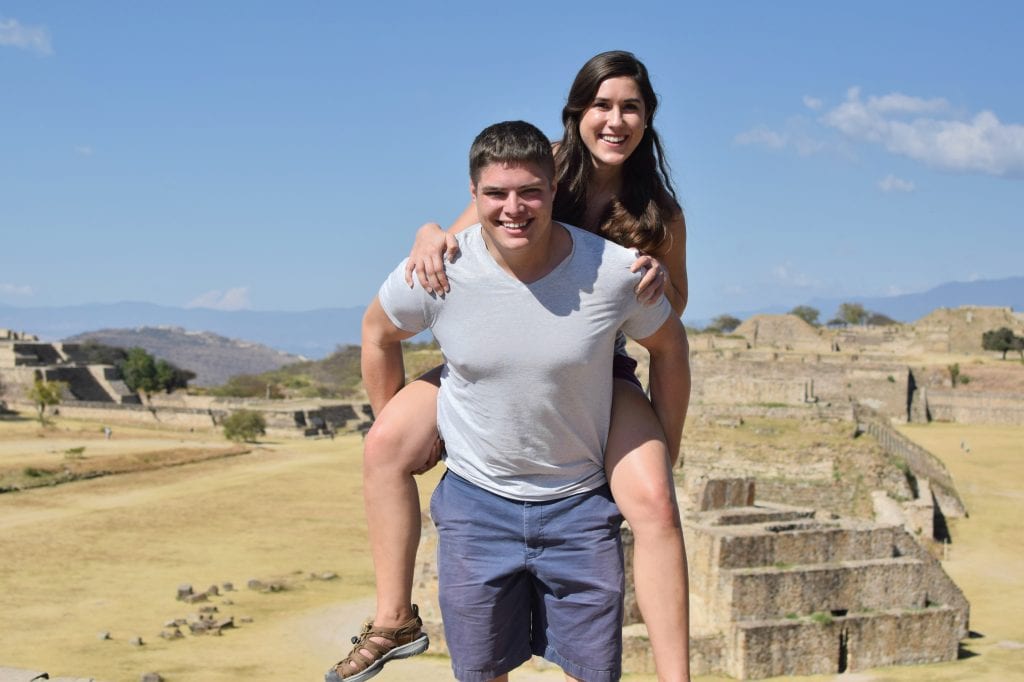
From Emily of Emily Embarks
Situated in the Campeche state of Mexico, Calakmul is home to nearly 6,800 different ancient ruin configurations, and yet only brings in, on average, less than 20,000 visitors per year.
Owing to its secluded location, easy access off a major highway, and endless historic beauty, Calakmul is easily one of the best ruins in Mexico!
Best accessed via guided tours due to its remote location within the Calakmul Biosphere Reserve, the ruins are truly an exciting experience.
Surrounded by wildlife including monkeys, vast varieties of birdlife, and even the possibility of spotting a wild jaguar, a visit to the Calakmul ruins is well worth the effort.
For visitors with their own car, your best route will be to travel from Xpujil 2 hours south through extremely dense jungle and ill-maintained roads.
Travelers should be sure to learn some basic Spanish before visiting on their own, as many of the local population in the area is monolingual.
English-speaking guides also book up far in advance, so be sure to plan ahead if you plan on visiting with a guide.
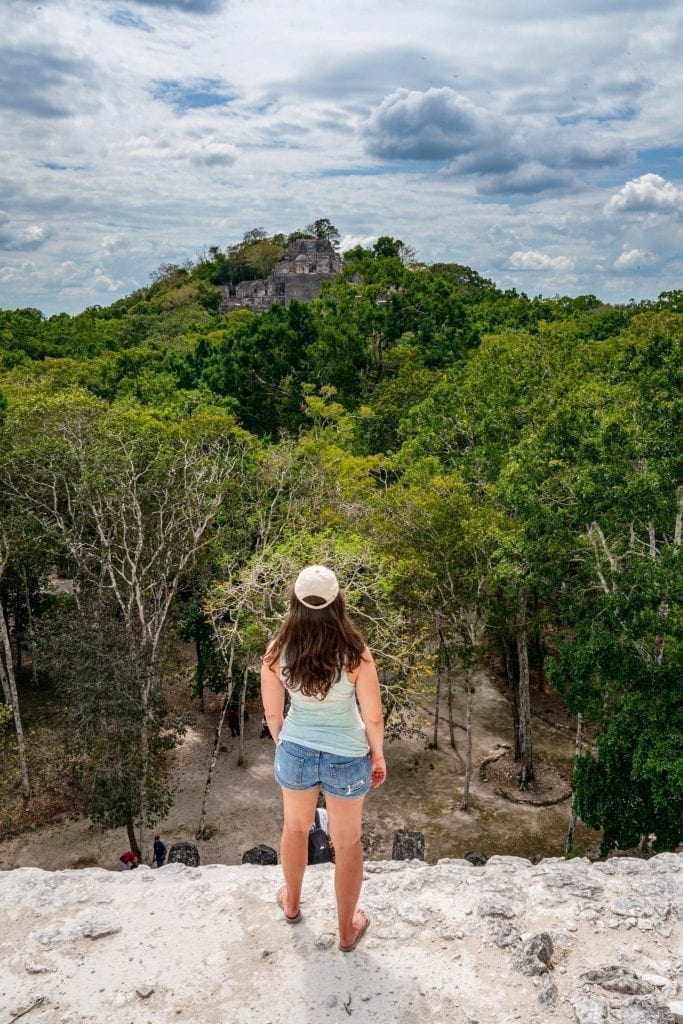
Once you arrive, take some time to explore Estructura II.
This is the largest ruin in the area and actually allows visitors to climb it! Just be respectful, please.
You can also get great views from Pyramid 2, and see some incredible architecture at the Mayan Ball Court and the Chiik Nahb Acropolis.
The secluded ancient ruins site of Calakmul is most commonly visited from Xpujil, which is within close proximity to the border of the Yucatan state.
Where to Visit Calakmul From
Just 90 minutes from the popular tourist town of Bacalar, guests can easily combine a visit to Calakmul with other popular spots along the Yucatan Peninsula.
Note from Kate : When Jeremy and I visited Calakmul, we had our own vehicle and still chose to hire a guide for navigation and context. Guided tours like this are a great value for Calakmul!
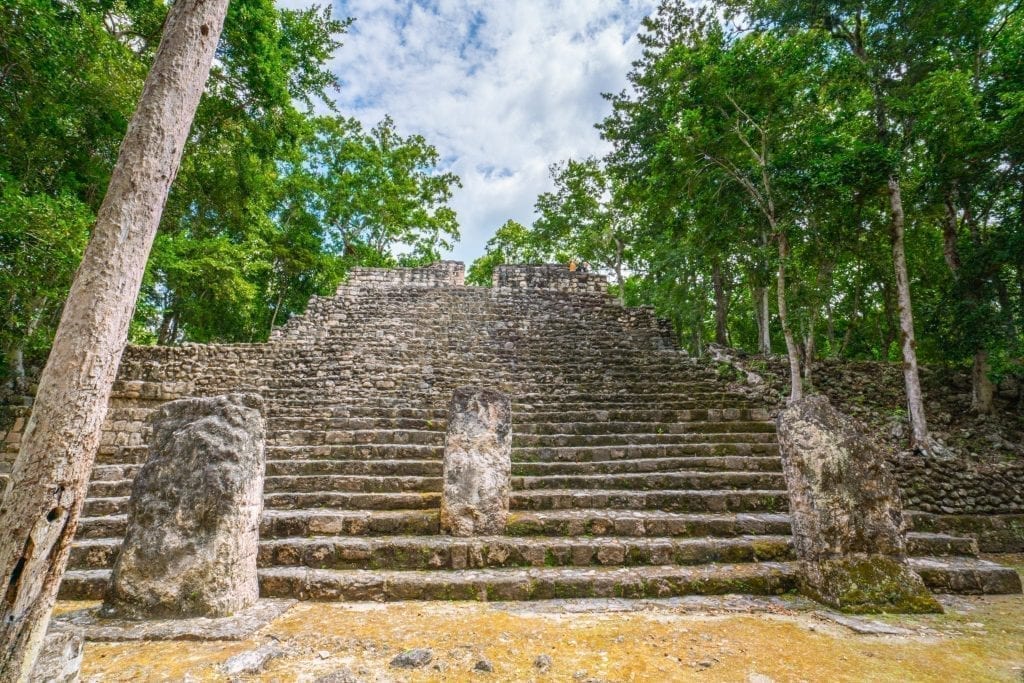
Yaxchilan Archaeological Site
From Megan of Packing Up the Pieces
Yaxchilan is an incredible Mayan archaeological site hidden in the Lacandona Jungle in Chiapas in Mexico.
Reaching the ruins is half the adventure, as it is only accessible via a 40-minute long boat ride that twists along the Usumacinta River.
The river acts as a natural border between Mexico and Guatemala and is a dramatic entrance to these spectacular Mayan ruins.
Wander through the site and follow the self-guided tour. Listen closely, you may hear howler monkeys in the backdrop.
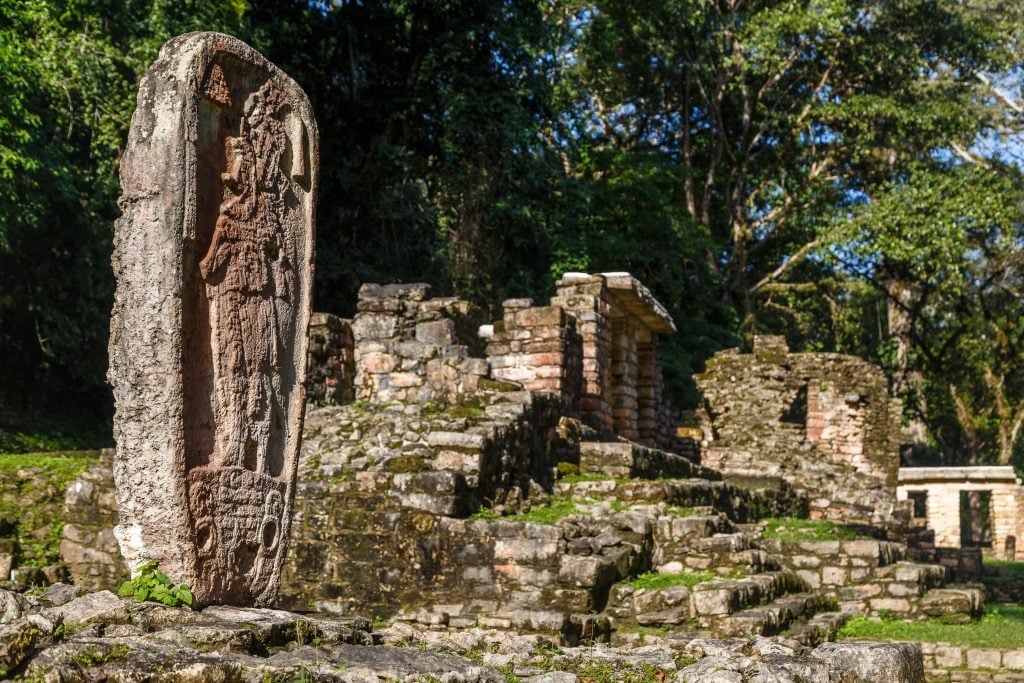
While the Yaxchilan ruins are not as large as other famous sites in Mexico, the isolated location in the heart of the jungle is mystical and can give the impression as if stepping back in time to this once powerful Mayan city.
Since the site is quite remote, walking among the ruins is a truly intimate experience.
Where to Visit Yaxchilan From
Most people will visit Yaxchilan as a long and organized day trip from Palenque .
However, bold travelers can add Yaxchilan and the gateway city of Frontera Corozal as a stop along a Chiapas road trip .
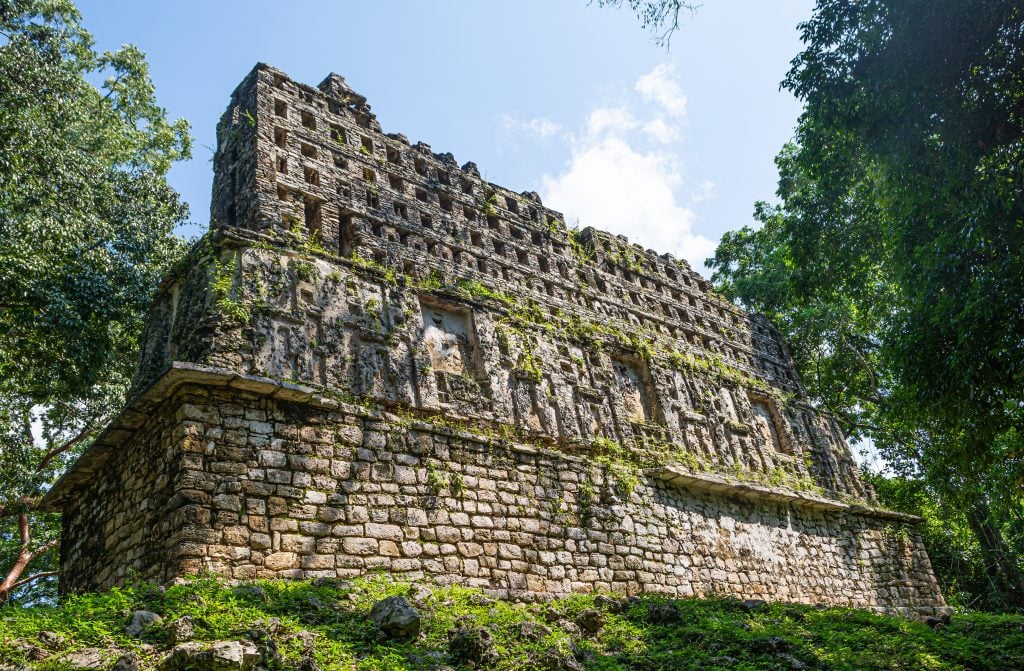
Set inside the shaded jungle of Chiapas, Palenque is one of the most interesting ruins in Mexico to visit.
This once medium-sized Mayan city in southern Mexico was active from 226 BCE until 799 AD.
How do we know those exact dates?
Unlike some of the more mysterious archaeological sites in the region, Palenque’s history has been able to be largely recovered thanks to the written records left carved into the many intricate buildings.
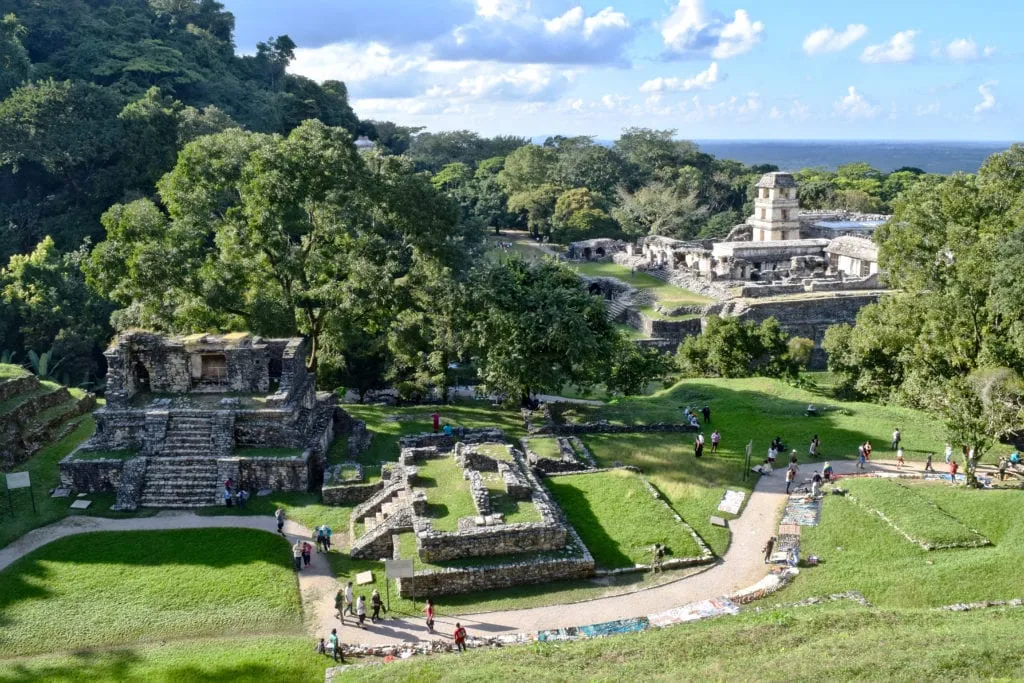
The site has now been largely reclaimed from the jungle and features pyramids to climb, buildings to enter, and detailed architecture to marvel at.
It also–unlike many of these Mexico ruins–features plenty of shade thanks to its jungle location, a welcome relief from the heat!
Where to Visit Palenque From
Palenque is popularly visited on day trips from San Cristobal , however, you can also choose to stay in the modern city of Palenque and visit independently from there.
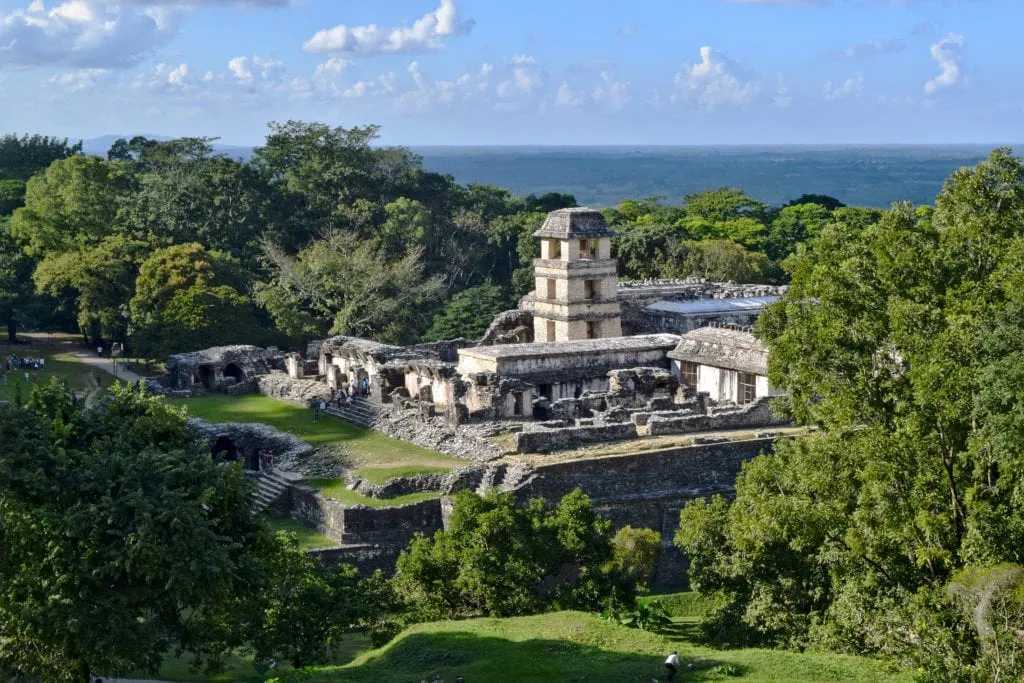
From Julien of Cultures Traveled
Tucked into the mountains and valleys surrounding Oaxaca City is Mitla, the second most important archeological site in Oaxaca.
While smaller than some of the other famous ruins in Mexico, it is no less significant.
Mitla was used as a sacred burial site by the Zapotecs who built it as a gateway between life and death.
The name comes from the Nahuatl word Mictlán, which means “place of the dead.”
It was later occupied by the Mixtecs and continued to be used as an important religious center when the Spanish arrived in the 1500s.
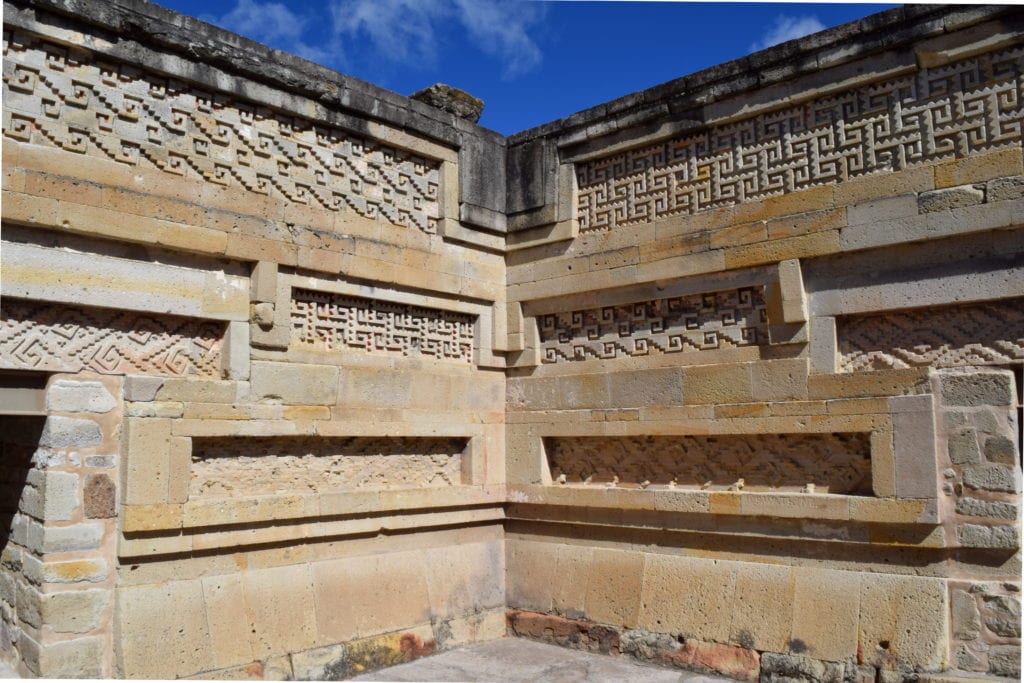
Mitla is also significant for the intricate mosaics that adorn many of the structures.
These geometric patterns are made with small polished stones that are meticulously fitted together without the use of mortar. It is the only archeological site in Mexico with this style of decoration.
Where to Visit Mitla From
A visit to Mitla can easily be incorporated into one of these day trips from Oaxaca .
To get there, take a collectivo to San Pablo de Mitla and walk through the small town to the entrance of the ruin.
The archeological site of Mitla is located an hour east of Oaxaca City on the way to Hierve el Agua.
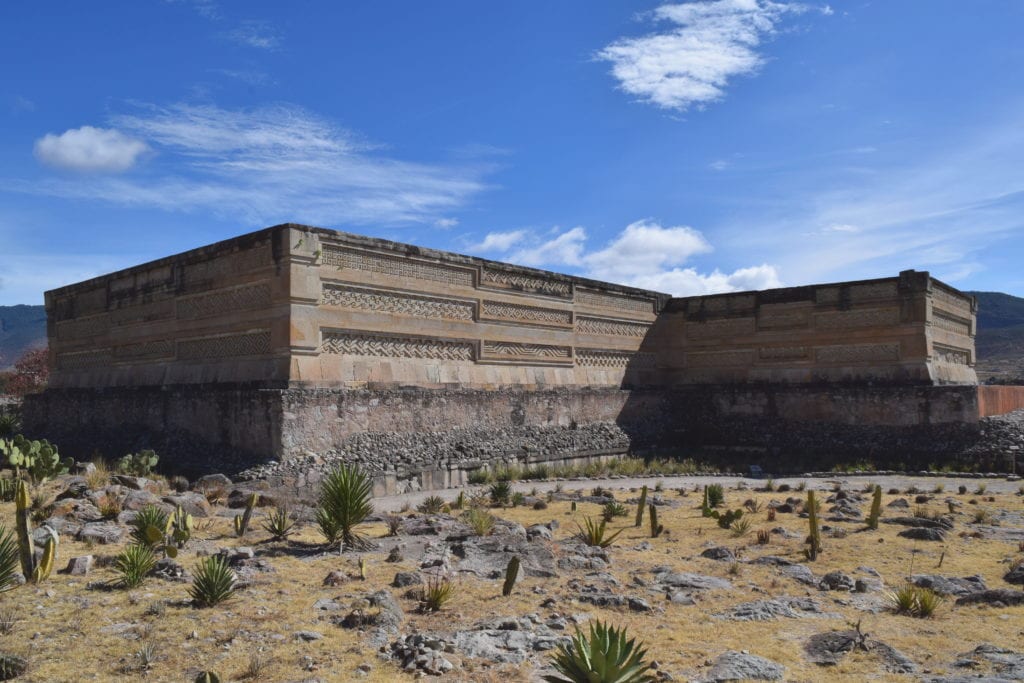
Teotihuacan
Sprawling and fascinating, Teotihuacan holds the distinction of one of the most mysterious Mexican ruins to visit.
Well, to start with–it’s not known who built it.
Teotihuacan is believed to have been settled by about 400 BCE and very powerful by 400 AD.
However, when the Aztecs arrived in the 1400s and took it over (they were the people who named it Teotihuacan), the city had been abandoned for centuries.
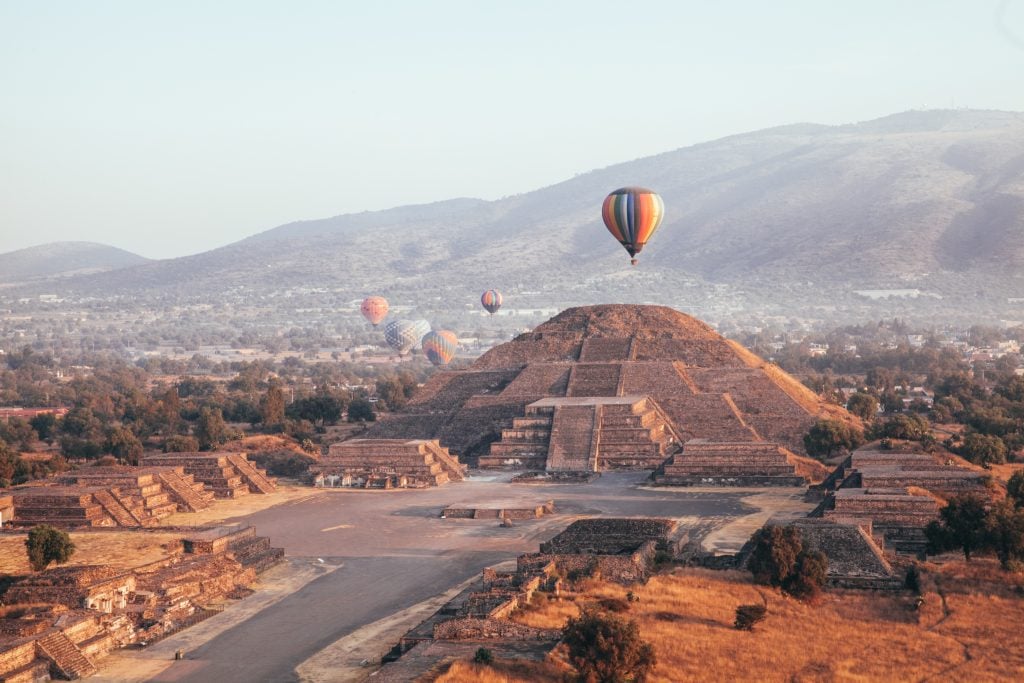
In addition to its mystery, Teotihuacan is also an incredibly fun archaeological site in Mexico to visit, featuring multiple pyramids to climb.
One of the most popular things to do in Teotihuacan for those in the mood for a splurge is to take a hot air balloon ride over the site in order to appreciate it from above.
Where to Visit Teotihuacan From
Teotihuacan is located about 30 miles northeast of Mexico City, and, along with spots like Tepoztlan , makes for a great day trip.
You can access the site by bus or by booking a guided tour .
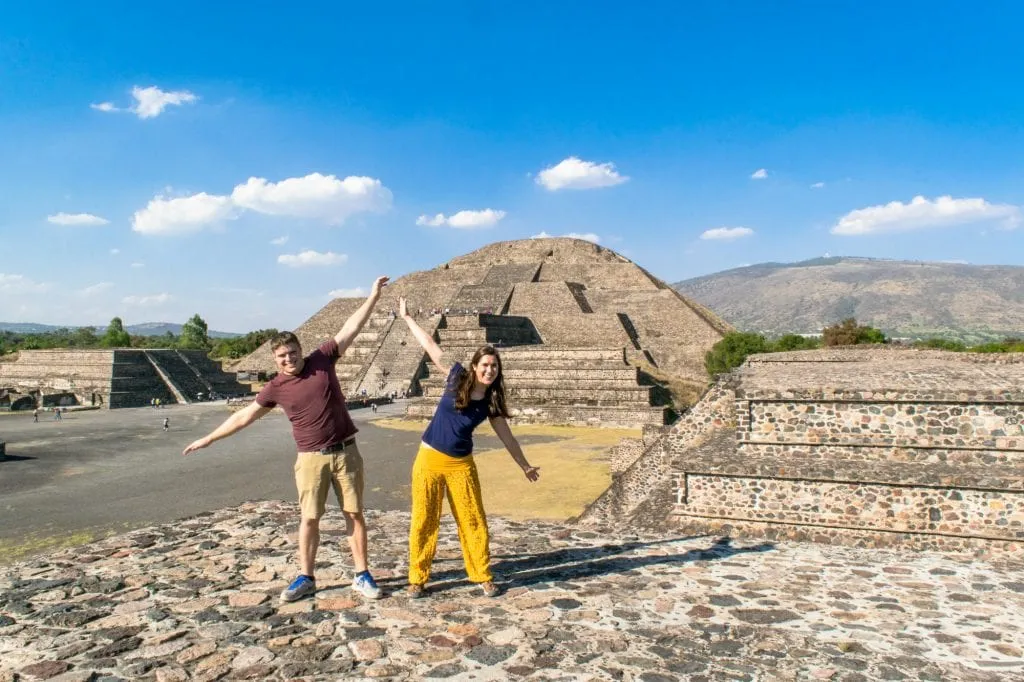
Tula Archaeological Site
From Daniel of Layer Culture
Tula ruins are located in the state of Hidalgo and are just 90 kilometers from Mexico City making it the perfect day trip for visitors.
Tula was once the action capital of the Toltecs and the archaeological site that remains today is close to the town of Tula de Allende which is situated northwest of Mexico City.
From Mexico City, you can expect a 2 hours journey and if traveling Mexico by bus , you can head over to Terminal Norte and book your ticket with a company named Ovnibus.
Arriving in Tula de Allende the ruins are a 10-minute walk away from the nearest bus stop, or you can take a taxi.
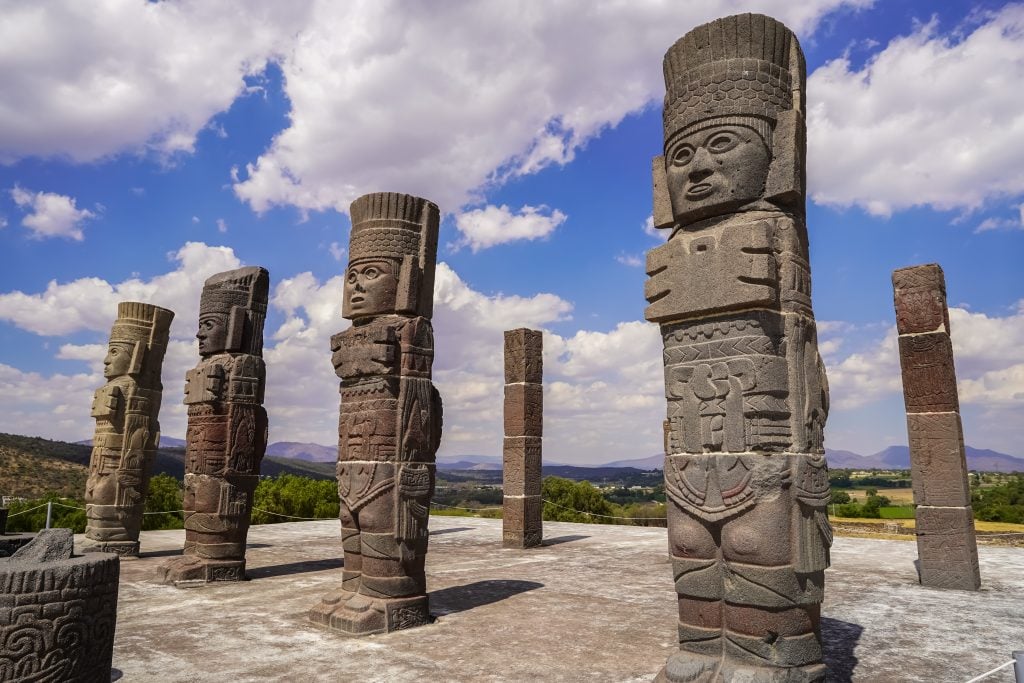
For most visitors to this site, the main attraction is the Pyramid of Quetzalcoatl which is topped by 5-meter basalt columns that are beautifully carved in the form of the Toltec warriors.
This ancient city thrived from the 9th to the 12th century and the Toltec warriors spread the cult of their feathered serpent god all over the empire: from central Mexico down to Central America.
Most of the local tour guides offer tours in Spanish and each of the landmarks displays descriptions in both Spanish and English.
The site must be seen to be fully appreciated and pyramids are fairly easy to climb for getting pictures of the site.
Where to Visit Tula From
Tula is an excellent day trip from Mexico City.
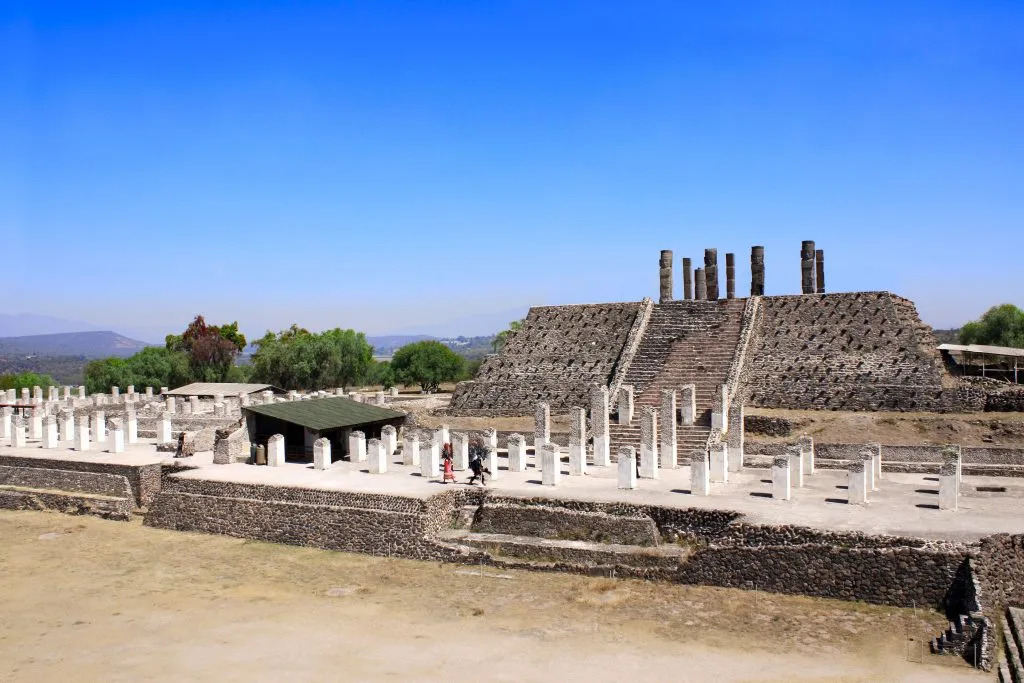
The Great Pyramid of Cholula
From Bailey of Destionationless Travel
The Great Pyramid of Cholula (also known as Tlachihualtepetl which means “made by hand mountain) is one of the most impressive archeological sites in Mexico.
First of all, this pyramid is the largest by volume in the entire world!
For comparison sake, Teotihuacán measures 220 meters by 230 meters at its base, whereas the Cholula Pyramid is 450 by 450 meters – it’s huge!
Surrounding the pyramid is also the remainder of the ancient city of Cholula. It’s said that this ancient city once had a population of 100,000 people!
You can walk around the different uncovered ruins and read about them on the information boards.
One thing that is important to note about the Great Pyramid of Cholula is that it is still covered.
In fact, when you arrive, it looks more or less like a big hill in the middle of the city with a church on top of it.
You can actually climb to the top and visit the church if you want. The view from up there is very impressive.
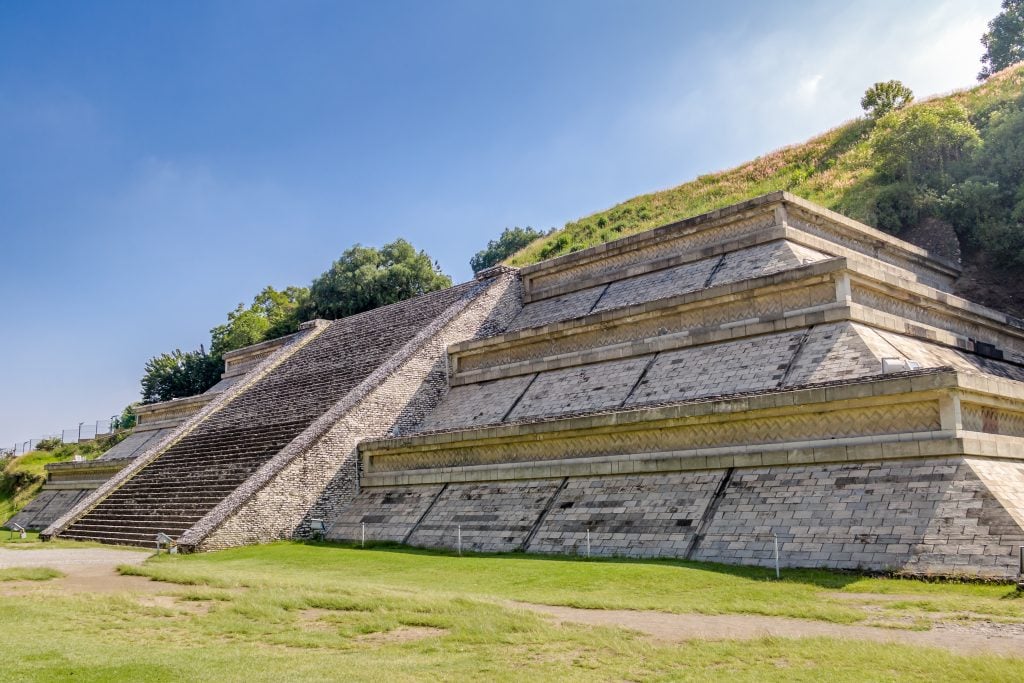
With that said, the best way to explore the Cholula Pyramid is from the inside. When you visit Cholula, you can actually go inside the pyramid and explore the underground tunnel system.
This is a very unique experience and something you won’t experience elsewhere in Mexico.
There are tons of different tunnels inside the pyramid and they total about 8 kilometers long.
The style of Cholula is often compared to Teotihuacan, as they both are Aztec ruins in Mexico. This also makes sense since both sites are geographically located pretty close to each other.
Where to Visit the Great Pyramid of Cholula From
The Great Pyramid of Cholula is located in a small town also called Cholula, located only about 4 kilometers from the city of Puebla, Mexico .
You can also visit Cholula on a day trip from Mexico City, but it is about a 2-3 hour drive away.
For this reason, many tourists base themselves in Puebla and visit Cholula from there.
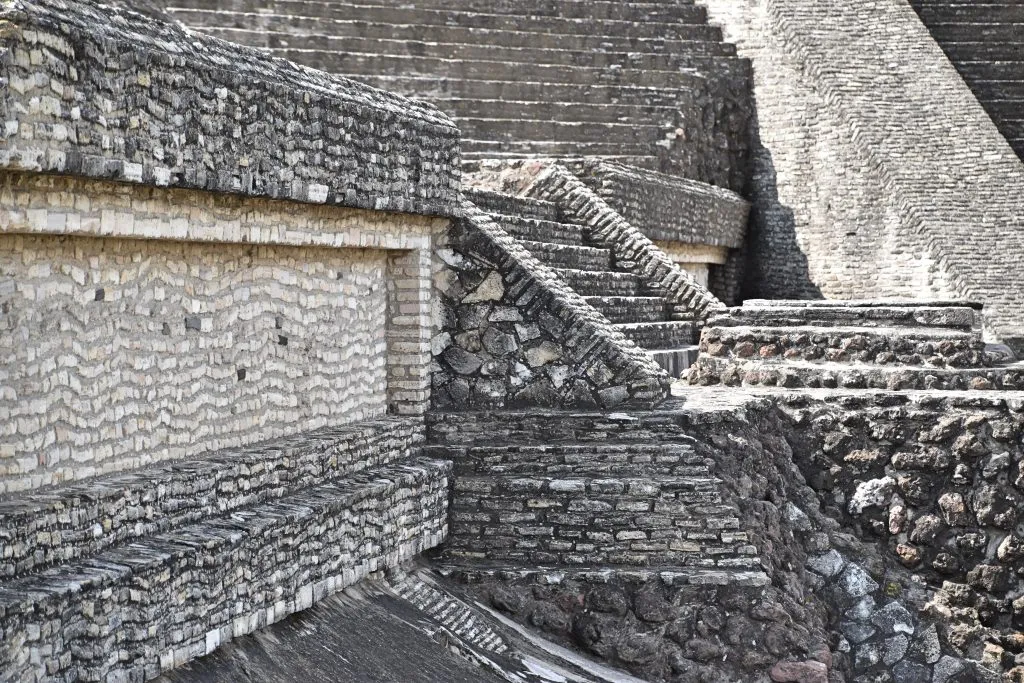
Guachimontones Pyramids
From Wendy of Empty Nesters Hit the Road
About an hour outside of Guadalajara, in the state of Jalisco, are the Guachimontones Pyramids ; circular, stepped, man-made structures built by the Teuchitlan people.
In fact, these are the only circular pyramids in the world!
It’s estimated they were built around 2,000 years ago.
While there are a few dozen sites in the area with similar pyramids, these are the best preserved and available to the public to view.
Today the pyramids are covered in grass and appear green, but it’s believed that they were originally painted red.
The best way to see Guachimontones is on an organized tour from Guadalajara , especially if you don’t speak Spanish.
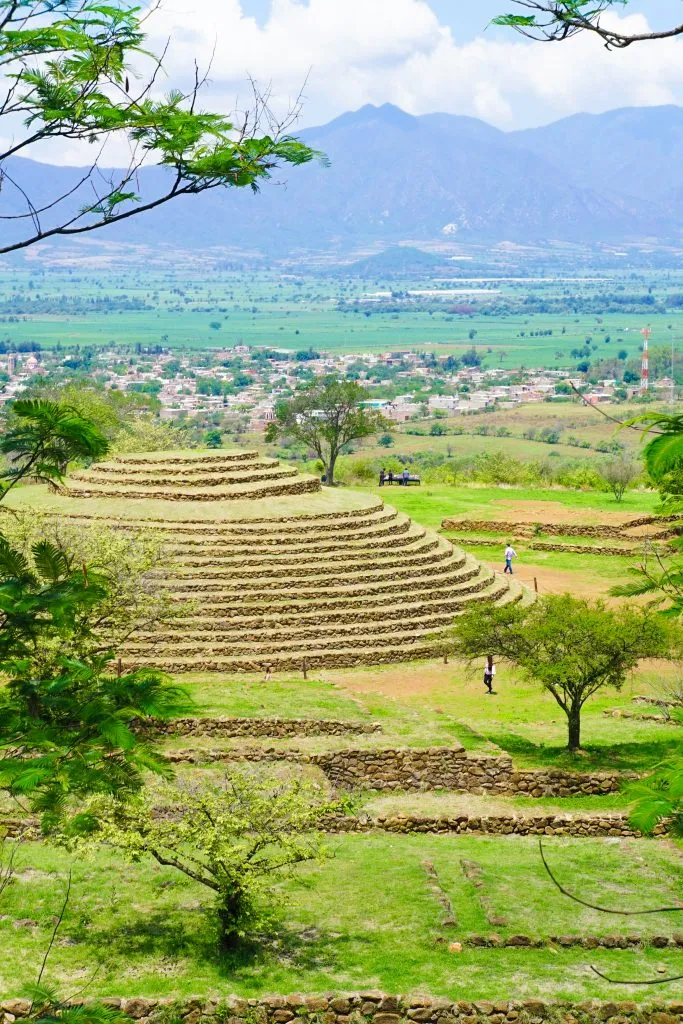
A guide will arrange transportation and provide the history of both the pyramids and the region.
The first stop at Guachimontones should be the Visitors Center. A short introductory film with English subtitles gives an overview of the entire area and the history of how it was discovered.
Next, explore the artifacts uncovered through archeological digs.
Then climb the hill to see the pyramids in person. To protect these structures, most cannot be climbed.
However, climbing is permitted on one of the crumbling pyramids which makes a great spot for photos.
Where to Visit Guachimontones From
The best option for overnight accommodations is in Guadalajara, a major Mexican city offering plenty of shopping, dining, and attractions.
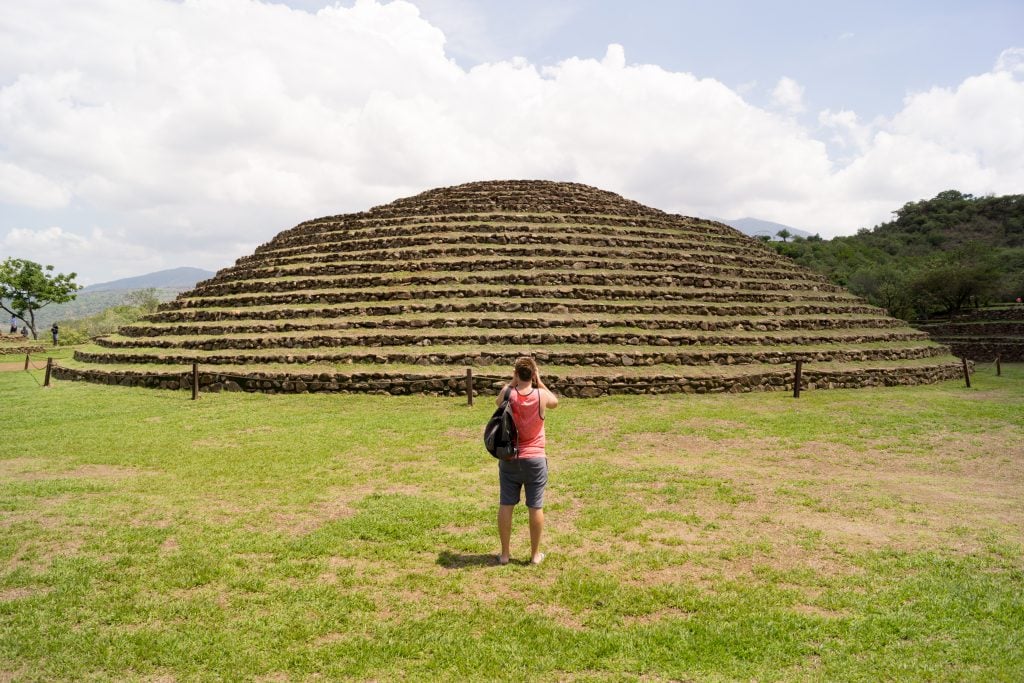
El Templo Mayor
From Katja of Globetotting
Located in the heart of Mexico City to one side of the enormous public square that is El Zócalo, is El Templo Mayor.
The Great Temple was the heart of the Aztec city of Tenochtitlan and where, according to legend, the Aztecs saw an eagle perching on a cactus with a snake in its beak.
Today this is the symbol on the Mexican flag.
The Templo Mayor saw many human sacrifices; the stepped pyramid’s staircase is where the bodies of those sacrificed were thrown once they had had their hearts ripped out.
Its gory history might not be for everyone but a visit to El Templo Mayor really is one of the best things to do in Mexico City .
When the Spanish conquistadors arrived in Mexico in 1519 they razed the main ceremonial temple and used stones from the fallen shrine to help build the Metropolitan Cathedral.
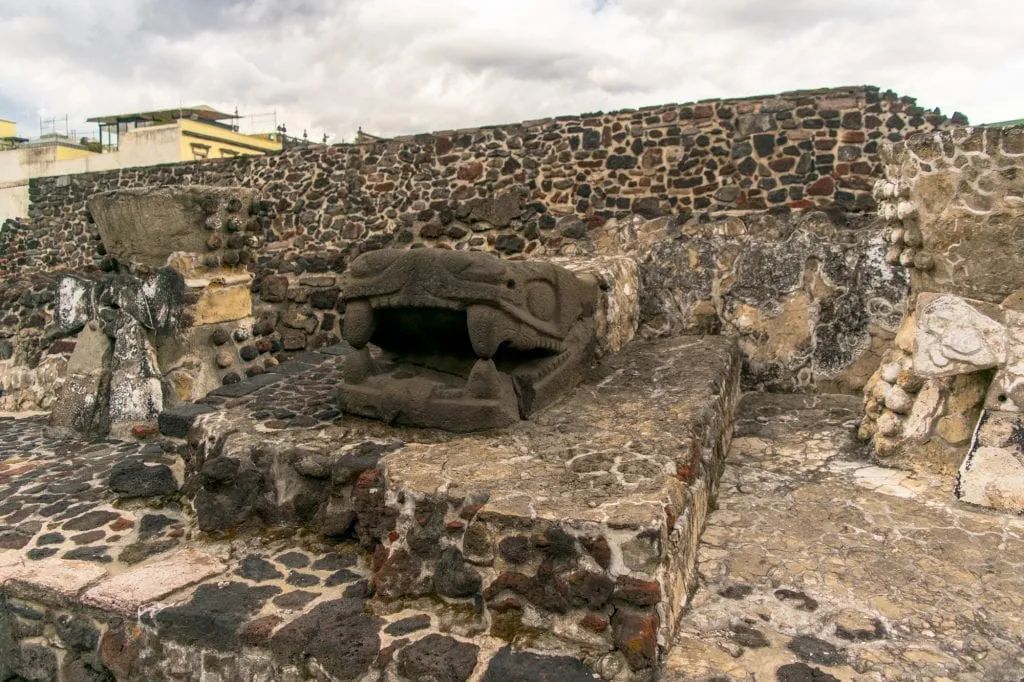
Amazingly, excavation on this major archaeological site only began in 1978 and much of the ancient Aztec city still lies beneath the modern city streets – it was only in 2011 that a ceremonial platform dating from 1469 was discovered.
Today you can visit what has been excavated of the Great Temple and the accompanying museum showcases all the objects discovered during the excavations.
Where to Visit El Templo Mayor From
El Templo Mayor is located in the heart of Mexico City, next door to the Metropolitan Cathedral and just steps from the Zocalo.
If you’re visiting Mexico City, this is undoubtedly one of the easiest Mexico ruins to visit!
Take This Map With You! Click each highlight to pull up the name of the destination. To save this map to “Your Places” on Google Maps, click the star to the right of the title. You’ll then be able to find it under the Maps tab of your Google Maps account! To open the map in a new window, click the button on the top right of the map.
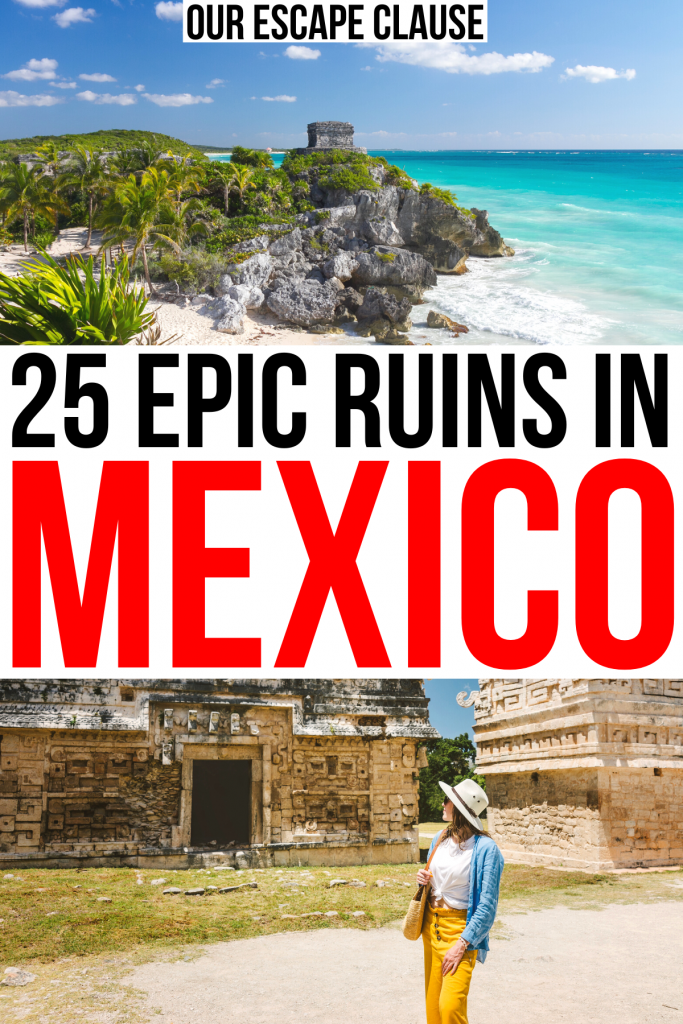
About Kate Storm

In May 2016, I left my suburban life in the USA and became a full-time traveler. Since then, I have visited 50+ countries on 5 continents and lived in Portugal, developing a special love of traveling in Europe (especially Italy) along the way. Today, along with my husband Jeremy and dog Ranger, I’m working toward my eventual goal of splitting my life between Europe and the USA.
Leave a Comment Cancel reply
National Geographic content straight to your inbox—sign up for our popular newsletters here

7 of the best Maya ruins to visit in Mexico
Remnants of ancient civilisations still stand across Central America — and well-preserved temples and jungle-cloaked pyramids are open to visitors across southern Mexico.
Before the Spanish colonised Central America in the 16th century, the ancient Maya were one of the most sophisticated civilisations in the Western Hemisphere. They developed a complex calendar system through their knowledge of astrology and mathematics, used intricate hieroglyphics to record their history and built large, lavishly decorated cities, complete with pyramids, temples, and plazas.
At its height, the ancient Maya civilisation comprised 40 cities across Central America, spanning southern Mexico, Guatemala, Honduras, Belize, El Salvador and Nicaragua. In the southern Mexican states of Yucatán, Quintana Roo and Chiapas, many of these settlements — the largest housed up to 50,000 people — still stand today, offering visitors a unique insight into the social, cultural and religious lives of the ancient Maya.
From carefully reconstructed sites like Chichen Itza to the wild, jungle-clad pyramids and ceremonial temples of Calakmul, these are the ancient Maya ruins not to miss in southern Mexico.
1. Chichen Itza
Named one of the New Seven Wonders of the World in 2007, the beautifully preserved Chichen Itza in Yucatán is Mexico’s most famous Maya ruin. Despite the crowds, few are disappointed with El Castillo — a carefully restored pyramid that rises up 80ft and has 365 steps — or the city’s tlachtli , the largest Maya ball court in the Americas.
Occupied until the 16th century, Tulum was one of the last cities inhabited by the Maya and the only one built by the coast. The pyramids here aren’t as large as other Maya ruins in Mexico, but the setting, on 40ft-high cliffs above turquoise Caribbean waters south of Cancun, more than makes up for it.
Home to the tallest pyramid in the state of Quintana Roo, Cobá was once one of the most important Maya cities in Yucatán. Located around 30 miles west of Tulum ruins, the city was built in around 600 CE and it eventually grew to 50,000 inhabitants. Though much of Cobá has yet to be excavated, travellers can climb the 138ft-high Nohoch Mul — a pyramid that offers sweeping views over the Yucatán jungle. Cobá is also known for its sophisticated sacbe, or ‘white road’2, network — limestone pathways that connect the city to neighbouring settlements.

4. Palenque
Deep in the jungles of northeastern Chiapas state in southern Mexico lies Palenque , a Late Classic Maya city known for its detailed hieroglyphic inscriptions and sculpted reliefs. These highly sophisticated designs have helped archaeologists understand more of the ancient Maya's history, mythology and calendar systems.
5. Calakmul
Cloaked by the second-largest expanse of tropical forests in the Americas, in Campeche’s Calakmul Biosphere Reserve near the border with Guatemala, Calakmul is one of Mexico’s wildest Maya ruins. It has the largest and tallest pyramid in Yucatán and more than 6,000 structures, many of them covered by jungle. The site is particularly beautiful at sunrise, when the surrounding jungle comes alive with birdsong, howler monkeys and, if you’re lucky, the roar of a jaguar.
6. Ek Balam
Around 25 miles north of the Yucatán city of Valladolid is Ek Balam , which means ‘black jaguar’ or ‘jaguar star’ in the Yucatec Maya language. The city reached its height in the eight century, when more than 20,000 people lived here. Its largest pyramid is 160 metres long and 105ft high, and contains the tomb of Ukit Kan Le´t Tok, the king of Ek Balam between 770 CE and around 797 CE. Archaeologists found the ruler buried with more than 7,000 pieces of jade, bone, ceramic, shell and precious metal, and the outside walls decorated with stone jaguars, winged creatures and human skulls.
A one-hour drive from the Yucatán capital of Merida is this seventh-century Maya city, once large enough to house 25,000 inhabitants. The Uxmal ruins are part of the Ruta Puuc, a 25-mile road network that connects Uxmal with the archaeological sites of Kabah, Sayil, Xlapak, Labná, Oxkintok, Grutas de Calcehtok and Grutas de Loltún.
Become a subscriber and support our award-winning editorial features, videos, photography, and much more.
For as little as $2/mo.
Related Topics
- HISTORIC SITES
- ADVENTURE TRAVEL
- PREHISTORIC CULTURES
- ANCIENT CIVILIZATIONS
You May Also Like

Albert Lin hunts for lost Maya cities in Mexico. Here’s how travelers can too

A guide to Guadalajara, the alternative Mexican city hosting this year's Gay Games

Photo story: ancient ruins and Indigenous culture in Mexico's Maya Ka'an region

Here are 6 of the world’s coolest dragon myths

It’s been called ‘the greatest museum of prehistoric art’—but few tourists know it exists
- Environment
- Paid Content
History & Culture
- History & Culture
- Terms of Use
- Privacy Policy
- Your US State Privacy Rights
- Children's Online Privacy Policy
- Interest-Based Ads
- About Nielsen Measurement
- Do Not Sell or Share My Personal Information
- Nat Geo Home
- Attend a Live Event
- Book a Trip
- Inspire Your Kids
- Shop Nat Geo
- Visit the D.C. Museum
- Learn About Our Impact
- Support Our Mission
- Advertise With Us
- Customer Service
- Renew Subscription
- Manage Your Subscription
- Work at Nat Geo
- Sign Up for Our Newsletters
- Contribute to Protect the Planet
Copyright © 1996-2015 National Geographic Society Copyright © 2015-2024 National Geographic Partners, LLC. All rights reserved

IMAGES
VIDEO
COMMENTS
Mexico's ancient Mayan ruins are really spectacular. These are the best Mayan archeological sites that you don't want to miss!
The best ruins in Mexico are all packed with history and uniqueness, and offer unmatched cultural experiences. Whether you’re heading to Cancun, Tulum, or Mexico City, impressive ruins await nearby.
So whether you’re looking for day trips from Cancun or Mexico City, or planning a ruins road trip, this guide will help you explore all the best ruins in Mexico. Throughout the guide, I’ll also share virtual tours and multimedia experiences for exploring the best ruins in Mexico from home!
Here's everything you ever wanted to know about the different Mayan ruins in Mexico including where they are and how to visit!
From climbing pyramids to learning about life in Mexico hundreds (or even a thousand) years ago, visiting the many incredible ruins in Mexico–with the Mayan and Aztec ruins being the most famous–is a fascinating experience.
From carefully reconstructed sites like Chichen Itza to the wild, jungle-clad pyramids and ceremonial temples of Calakmul, these are the ancient Maya ruins not to miss in southern Mexico.